University of Pennsylvania
The University of Pennsylvania (also known as Penn[14] or UPenn[15]) is a private Ivy League research university in Philadelphia. Established in 1740 by Benjamin Franklin, it is the fourth-oldest institution of higher education in the United States and among the highest-ranked universities in the world by multiple organizations.[note 1]
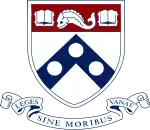 Coat of arms of the University of Pennsylvania | |
| Latin: Universitas Pennsylvaniensis | |
Former names | Academy and Charitable School in the Province of Pennsylvania (1751–1755) College of Philadelphia (1755–1779, 1789–1791)[1] University of the State of Pennsylvania (1779[2]–1791) |
|---|---|
| Motto | Leges sine moribus vanae (Latin) |
Motto in English | "Laws without morals are useless" |
| Type | Private research university |
| Established | November 14, 1740[note 1] |
| Founder | Benjamin Franklin |
| Accreditation | MSCHE |
Academic affiliations |
|
| Endowment | $20.7 billion (2022)[6] |
| Budget | $3.5 billion (2020)[7] |
| President | M. Elizabeth Magill |
| Provost | Beth Winkelstein (interim)[8] |
| Board chairman | Scott L. Bok[9] |
Academic staff | 4,793 (2018)[10] |
Total staff | 39,859 (Fall 2020; includes health system)[11] |
| Students | 22,432 (Fall 2019)[12] |
| Undergraduates | 10,019 (Fall 2019)[12] |
| Postgraduates | 12,413 (Fall 2019)[12] |
| Location | , , United States 39.95°N 75.19°W |
| Campus | Large City, 1,085 acres (4.39 km2) (total); 299 acres (1.21 km2), University City campus; 694 acres (2.81 km2), New Bolton Center; 92 acres (0.37 km2), Morris Arboretum |
| Other campuses | San Francisco |
| Newspaper | The Daily Pennsylvanian |
| Colors | Penn Red Penn Blue[13] |
| Nickname | Quakers |
Sporting affiliations |
|
| Mascot | The Quaker |
| Website | https://www.upenn.edu/ |
 | |
The University has four undergraduate schools as well as twelve graduate and professional schools. Schools enrolling undergraduates include the College of Arts and Sciences, the School of Engineering and Applied Science, the Wharton School, and the School of Nursing. Among its highly ranked graduate schools are its law school, whose first professor wrote the first draft of the United States Constitution, its medicine school, the first in North America, and Wharton, the first collegiate business school. Penn's endowment is US$20.7 billion, putting it amongst the wealthiest academic institutions in the world, and its 2019 research budget was $1.02 billion.
Penn was one of nine colonial colleges chartered before the U.S. Declaration of Independence when Benjamin Franklin, the university's founder and first president, advocated for an educational institution that trained leaders in academia, commerce, and public service. The campus, in the University City neighborhood of Philadelphia, is centered around College Hall, and notable landmarks are Houston Hall, the first modern "student union", Morris Arboretum, the official arboretum of the Commonwealth of Pennsylvania and Franklin Field, the first double-decker college football stadium. The university's athletics program, the Quakers, fields varsity teams in 33 sports as a member of the NCAA Division I Ivy League conference.
Throughout its existence, Penn alumni, trustees, and/or faculty have included 8 signers of the Declaration of Independence, 7 signers of the U.S. Constitution, 2 Presidents of the United States, 3 Supreme Court justices, 32 U.S. senators, 163 members of the U.S. House of Representatives, 12 U.S. Cabinet Secretaries, 46 governors, and 9 foreign heads of state. Alumni and or faculty include 36 Nobel laureates and 33 Rhodes Scholars. Penn alumni (a) have won 28 Tony Awards, 16 Grammy Awards, 11 Emmy Awards, and 4 Academy Awards and (b) include one of only 17 people who have earned all 4 awards (an EGOT). In addition, Penn has the greatest number of alumni on the Forbes 400 list of the wealthiest Americans out of all colleges and has the greatest number of undergraduate billionaire alumni of all colleges, with 64 living billionaires, 28 of whom are alumni of Penn's undergraduate schools. Penn alumni have won 81 Olympic medals (26 of them gold). Two Penn alumni have been NASA astronauts and 5 have been awarded the United States Armed Forces' highest award for gallantry, the Medal of Honor.[16][17]
History
Origins of the college
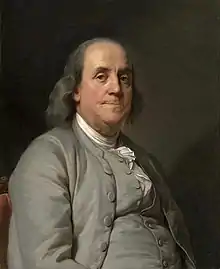
The University of Pennsylvania considers itself the fourth-oldest institution of higher education in the United States, though this is contested by Princeton and Columbia Universities.[note 2]
In 1740, a group of Philadelphians joined to erect a great preaching hall for the traveling evangelist George Whitefield, who toured the American colonies delivering open-air sermons. The building was designed and built by Edmund Woolley and was the largest building in the city at the time, drawing thousands of people the first time in which it was preached.[28]: 26 It was initially planned to serve as a charity school as well, but a lack of funds forced plans for the chapel and school to be suspended. According to Franklin's autobiography, it was in 1743 when he first had the idea to establish an academy, "thinking the Rev. Richard Peters a fit person to superintend such an institution". However, Peters declined a casual inquiry from Franklin (though Peters was one of Penn's founding trustees [1749 to 1776], President of board of trustees [1756 to 1764], and Treasurer of board of trustees [1769 to 1770][29]) and nothing further was done by Franklin for another six years when he again contacted not just Peters but many others.[28]: 30 In the fall of 1749, now more eager to create a school to educate future generations, Benjamin Franklin circulated a pamphlet titled "Proposals Relating to the Education of Youth in Pensilvania", his vision for what he called a "Public Academy of Philadelphia".[30]

Unlike the other colonial colleges that existed in 1749—Harvard, William & Mary, Yale, and the College of New Jersey—Franklin's new school would not focus merely on education for the clergy. He advocated an innovative concept of higher education, one which would teach both the ornamental knowledge of the arts and the practical skills necessary for making a living and doing public service. The proposed program of study could have become the nation's first modern liberal arts curriculum, although it was never implemented because Anglican priest William Smith (1727–1803), who became the first provost, and other trustees strongly preferred the traditional curriculum.[32][33]
Franklin assembled a board of trustees from among the leading citizens of Philadelphia, the first such non-sectarian board in America. At the first meeting of the 24 members of the board of trustees on November 13, 1749, the issue of where to locate the school was a prime concern. Although a lot across Sixth Street from the old Pennsylvania State House (later renamed and famously known since 1776 as "Independence Hall"), was offered without cost by James Logan, its owner, the trustees realized that the building erected in 1740, which was still vacant, would be an even better site.

The original sponsors of the dormant building still owed considerable construction debts and asked Franklin's group to assume their debts and, accordingly, their inactive trusts. On February 1, 1750, the new board took over the building and trusts of the old board. On August 13, 1751, the "Academy of Philadelphia", using the great hall at 4th and Arch Streets, took in its first secondary students. A charity school also was chartered on July 13, 1753,[35]: 12 by the intentions of the original "New Building" donors, although it lasted only a few years. On June 16, 1755, the "College of Philadelphia" was chartered, paving the way for the addition of undergraduate instruction.[35]: 13 All three schools shared the same board of trustees and were considered to be part of the same institution.[36] The first commencement exercises were held on May 17, 1757.[35]: 14
_1755.jpg.webp)
The institution of higher learning was known as the College of Philadelphia from 1755 to 1779. In 1779, not trusting then-provost the Reverend William Smith's "Loyalist" tendencies, the revolutionary State Legislature created a "University" (which in 1785 the legislature changed name to University of the State of Pennsylvania).[36][37] The result was a schism, with Smith continuing to operate an attenuated version of the College of Philadelphia. In 1791, the legislature issued a new charter, merging the two institutions into a new University of Pennsylvania with twelve men from each institution on the new board of trustees.[36]
Although Penn began operating as an academy or secondary school in 1751 and obtained its collegiate charter in 1755, it initially designated 1750 as its founding date; this is the year that appears on the first iteration of the university seal. Sometime later in its early history, Penn began to consider 1749 as its founding date and this year was referenced for over a century, including at the centennial celebration in 1849.[38] In 1899, the board of trustees voted to adjust the founding date earlier again, this time to 1740, the date of "the creation of the earliest of the many educational trusts the University has taken upon itself".[39] The board of trustees voted in response to a three-year campaign by Penn's General Alumni Society to retroactively revise the university's founding date to appear older than Princeton University, which had been chartered in 1746.[40]
First university
The University of Pennsylvania also considers itself as the first university in the United States with both undergraduate and graduate studies. Penn has two claims to being the first university in the United States, according to the former university archives director Mark Frazier Lloyd:
- (1) the 1765 founding of the first medical school in America[41] made Penn the first institution to offer both "undergraduate" and professional education ("the 'de facto' position")

Original campus
The Academy of Philadelphia, a secondary school for boys, began operations in 1751 in an unused church assembly hall building at 4th and Arch Streets which had sat unfinished and dormant for over a decade. Upon receiving a collegiate charter in 1755, the first classes for the College of Philadelphia were taught in the same building, in many cases to the same boys who had already graduated from The Academy of Philadelphia. When the British abandoned Philadelphia during the Revolutionary War, Penn's then only academic building "College Hall"[45] served as temporary meeting site of the Second Continental Congress (from July 2 to July 13, 1778)[46] as the British armed forces extensively damaged many parts of the city including the Pennsylvania State House (now known as Independence Hall), the site in which the Second Continental Congress had convened on May 10, 1775 and had been forced to abandon on December 12, 1776 to escape capture by the British.[47] The Second Continental Congress delegates returned to Philadelphia on learning of the British retreat and by July 7, 1778, acquired a quorum, and thus were able to re-convene Congress on Penn's College of Philadelphia campus (briefly establishing Penn as site of capital of the United States).[48] Such status as capital of the United States is evidenced by letter sent on July 13, 1778, from Josiah Bartlett (a signatory to the Articles of Confederation and the Declaration of Independence) to John Langdon (who was Bartlett's fellow New Hampshire "Founding Father" as Langdon later became a signatory of the United States Constitution):
"The Congress meets in the College Hall[49] as the State House was left by the enemy in a most filthy and sordid situation, as were many of the public and private buildings in the City."
9th Street campus
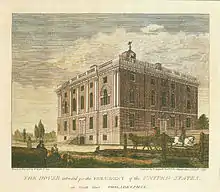
In 1801, the university moved to the unused Presidential Mansion at 9th and Market Streets, a building that both George Washington and John Adams had declined to occupy while Philadelphia was the temporary national capital.[35]
Among the classes given in 1807 at this building were those offered by Benjamin Rush, a professor of chemistry, medical theory, and clinical practice who was also a signer of the United States Declaration of Independence, member of the Continental Congress,[52][53] and surgeon general of the Continental Army.[54]
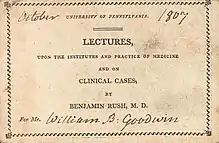
Classes were held in the mansion until 1829 when it was demolished. Architect William Strickland designed twin buildings on the same site, College Hall[55] and Medical Hall (both 1829–1830), which formed the core of the Ninth Street Campus until Penn's move to West Philadelphia in the 1870s.
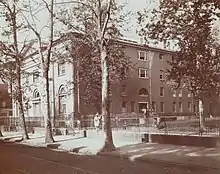
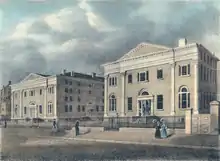
West Philadelphia campus
After being located in downtown Philadelphia for more than a century, the campus was moved across the Schuylkill River to property purchased from the Blockley Almshouse in West Philadelphia in 1872, where it has since remained in an area now known as University City.
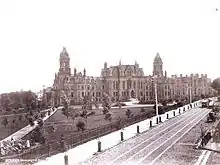
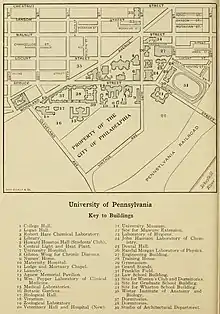
_(14784617513).jpg.webp)
Residential university
In the 1750s, roughly 40 percent of Penn students needed lodging as they came from areas too far to commute including other colonies in the South or the West Indies.[58] Before the completion of the construction of the first dormitory in 1765, out of town students were typically placed with "guardians" in the homes of faculty or in suitable boarding houses (such as the one run by widow Rachel Marks Graydon, mother of Penn College Class of 1775 (who did not graduate) alumnus Alexander Graydon).[59][60]
_(14578281487).jpg.webp)
In 1765, the campus was expanded by the opening of the newly completed dormitory run by Ben Franklin's collaborator on study of electricity using electrostatic machines and related technology and Penn Professor and "chief master" Ebenezer Kinnersley.[61] Kinnersley was designated "steward" of the students in the dormitory and he and his wife were given "powers of discipline" over the students and supervised the cleanliness of the students with respect to personal hygiene and washing of the students' dirty clothing.[62][63] However, even after its construction, many students sought living quarters elsewhere, where they would have more freedom resulting in loss of funds to Penn such that in fall of 1775, Penn's trustees voted to advertise to lease the dormitory to a private family who would board the pupils at lesser cost to Penn.[64] In another attempt to control the off-campus activities of the students, the trustees agreed not to admit any out-of-town student unless he was lodged in a place which they and the faculty considered proper.[58] As of 1779, Penn, through its Trustees, owned three houses on Fourth Street, just north of the campus's "New Building" with the largest residence located on the corner of Fourth and Arch Streets.[65][58]
Starting in 1849 (with formation of Penn's Eta chapter[66] of Delta Phi (St. Elmo) by five founders and fifteen "initiates",[67] Penn students began to establish chapters of and live in houses rented or owned by fraternities. Since Penn only had limited housing near campus and since students (especially the students at the medical school who) came from all over the country, the students elected to fend for themselves rather than live in housing owned by Penn trustees and good number chose housing by pledging and living in Penn's first fraternities (Delta Phi, Zeta Psi, Phi Kappa Sigma, and Delta Psi).[68] These first fraternities were located in walking distance of 9th and Chestnut (as campus was located from 1800 to 1872 on West side of 9th Street, from Market Street on the North to Chestnut Street on the South). For example, Zeta Psi Fraternity was located at Southeast corner of 10th Street and Chestnut Street, Delta Phi was located on South side of 11th Street near Chestnut Street, and Delta Psi was located on North side of Chestnut Street, West of 10th Street.[69] When Penn moved West in 1872 to its "new" campus (centered on the intersection of Woodland Avenue, 36th Street, and Locust Street) so did the fraternities. Among the first fraternities to build near the new campus were Phi Delta Theta in 1883 and Psi Upsilon in 1891. By 1891 there were at least seventeen fraternities at the university.[70]
From its founding until construction of the Quadrangle Dormitories, which started construction in 1895, the student body did not live in university-owned housing as, with a significant exception in the 18th century (see above content and Wikimedia image of the sketch of first Penn owned dormitory), there was none. Indeed, a significant portion of the undergraduate population commuted from Delaware Valley and a large number of students resided in the Philadelphia area.[71] The medical school (with roughly half the students) was a significant exception to this trend as it attracted a more geographically diverse population of students. For example, in the 1850s when Penn's medical school accounted for two-thirds to three-quarters of the student body, over half of the population of the medical school was from the southern part of the United States.[72][73]
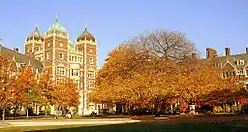
Penn had increasing need for housing in the last decade of 19th century and first decades of the twentieth century due to number of factors including its competition for students with peer institutions and active recruitment of foreign students.
With respect to the desire to compete with peer institutions to attract students from across the nation, such was aptly reported by George Henderson, President of the College Class of 1889 (in his monograph he distributed to his classmates at their 20th reunion), which charted not only Penn's strong growth in acreage and number of buildings over the prior two decades but also the near-quadrupling in the size of the student body, which was accommodated, in part, by building of the Men's Dormitory, the Quadrangle.[76] Henderson argued that building The Quad played a vital role in attracting students, and made an impassioned plea for its expansion:[77]
And the new buildings? First of all there is need of greater dormitory room. Did you ever live in the "dorms?" Then you do not know what "dorm" life means for college spirit. Several hundred men who live in the same big family have a feeling of common fellowship. Life in the "dorms" develops what our sociologists call a "Solidarity of Responsibility." Men who live there learn to care for the associations that brought them together, that keep them related. And this college spirit they never lose or forget.
Some parents, living at a distance, do not like to send their sons to live in a general boarding house. But a dormitory, a University institution, appeals to them, and the boys come and live there.
You would scarcely believe it, but when College opened last fall not only were the dormitory rooms over subscribed, but there was a long list of anxious ones, ready to snap up the room of any unlucky fellow who might miss his examinations, and be forced to spend another year at preparatory school grind. So we need the new dormitories, and although they are going up steadily, they might well go up faster.[77]
With respect to the active recruitment of foreign students, for example, Penn's first director of publicity translated a Penn recruiting brochure into Spanish and circulated approximately 10,000 copies throughout Latin America. The success of such efforts were evident in fall of 1910 when Vice Provost Edgar Fahs Smith (who the following year would start a ten-year tenure as Penn's provost) formally welcomed to Penn students from 40 different nations at an annual party.[78][79][80][81][82] Vice Provost Fahs spoke about how Penn wanted to "bring together students of different countries and break down misunderstandings existing between them".[83]
Since it was difficult to house the international students due to the then socially acceptable and legally permissible racist housing regulations extant in Philadelphia and across the United States, in fall of 1911, The Christian Association at The University of Pennsylvania hired as its first Foreign Mission Secretary, Reverend Alpheus Waldo Stevenson.[84] By 1912, Stevenson focused almost all his efforts on the foreign students at Penn who needed help finding housing resulting in the Christian Association, buying 3905 Spruce Street contiguous to Penn's campus.[85] By January 1, 1918, 3905 Spruce Street officially opened under the sponsorship of the Christian Association as a Home for Foreign Students, which came to be known as the International Students' House with Reverend Stevenson as its first director. The International Students' House provided " ... counseling and information services for a host of problems foreign students might encounter, including language, financial, health and diet, immigration and technical problems as well as maladjustment to living in the United States. It was also used for recreation and leisure, as lounges had radio, phonograph and television facilities and there were game and reception rooms. The International Students' House also provided for programs including forums, debates, lectures, panels and planned trips and outings as well as weekend activities such as dances, films and game nights. Also, for the next thirty-three years, the International Students' House would be sponsored by the Christian Association of the University of Pennsylvania."[86]
The success of efforts to reach out to the international students' was reported in 1921 when the official Penn publicity department reported that of the over 12,000 students at Penn (who came from all 50 states), 253 students came from at least 50 foreign countries and foreign territories, including India, South Africa, New Zealand, Australia, " ... every Latin American country, and most of the Oriental and European nations".[87]
By 1931, first-year students were required to live in the quadrangle unless they received official permission to live with their families or other relatives.[72] However, throughout this period and into the early post-World War II period, the undergraduate schools of the university continued to have a large commuting population.[88] As an example, into the late 1940s, two-thirds of Penn women students were commuters.[89]
After World War II, Penn began a capital spending program to overhaul its campus, especially student housing. A large number of students migrating to universities under the GI Bill, and the resultant increase in Penn's student population, highlighted that Penn had outgrown previous expansions, which ended during the Depression-era. Nonetheless, in addition to a significant student population from the Delaware Valley, Penn attracted international students from at least 50 countries and from all 50 states as early as the second decade of the 20th century.[87][90] Referring to the expansion in students (particularly from the Delaware Valley) due to Servicemen's Readjustment Act of 1944 (commonly known as the G.I. Bill),[91] Penn Trustee Paul Miller remarked about Penn's undergraduate housing situation in the post World War Two era that: "[t]he bricks-and-mortar Capital Campaign of the Sixties...built the facilities that turned Penn from a commuter school to a residential one...."[92] By 1961, 79% of male undergraduates and 57% of female undergraduates lived on campus.[93]
Controversies
From 1930 to 1966, there were 54 documented Rowbottom riots, a student tradition of rioting which included everything from car smashing to panty raids.[94] After 1966, there were five more instances of "Rowbottoms", the latest occurring in 1980.[94]
In 1965, Penn students learned that the university was sponsoring research projects for the United States' chemical and biological weapons program.[95] According to Herman and Rutman, the revelation that "CB Projects Spicerack and Summit were directly connected with U.S. military activities in Southeast Asia", caused students to petition Penn president Gaylord Harnwell to halt the program, citing the project as being "immoral, inhuman, illegal, and unbefitting of an academic institution".[95] Members of the faculty believed that an academic university should not be performing classified research and voted to re-examine the university agency which was responsible for the project on November 4, 1965.[95]
In 1983, members of the Animal Liberation Front broke into the Head Injury Clinical Research Laboratory in the School of Medicine and stole research audio and video tapes. The stolen tapes were given to PETA who edited the footage to create a film, Unnecessary Fuss. As a result of media coverage and pressure from animal rights activists, the project was closed down.[96]
The school gained notoriety in 1993 for the water buffalo incident in which a student who told a group of mostly black female students to "shut up, you water buffalo" was charged with violating the university's racial harassment policy.[97]
In 2022, some asked for the tenure of a University of Pennsylvania law school professor to be revoked after she said the country is "better off with fewer Asians."[98][99]
Educational innovations
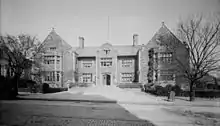
Penn's educational innovations include the nation's first medical school in 1765; the first university teaching hospital in 1874; the Wharton School, the world's first collegiate business school, in 1881; the first American student union building, Houston Hall, in 1896;[100] the country's second school of veterinary medicine; and the home of ENIAC, the world's first electronic, large-scale, general-purpose digital computer in 1946. Penn is also home to the oldest continuously functioning psychology department in North America and is where the American Medical Association was founded.[101][102] In 1921, Penn was also the first university to award a PhD in economics to an African-American woman, Sadie Tanner Mossell Alexander (in economics).[103]

Motto
Penn's motto is based on a line from Horace's III.24 (Book 3, Ode 24), quid leges sine moribus vanae proficiunt?, 'of what avail empty laws without [good] morals?'. From 1756 to 1898, the motto read Sine Moribus Vanae. When it was pointed out that the motto could be translated as 'Loose women without morals', the university quickly changed the motto to literae sine moribus vanae, 'Letters without morals [are] useless'.
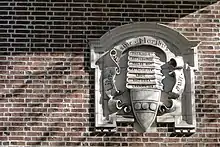
In 1932, all elements of the seal were revised. As part of the redesign, it was decided that the new motto "mutilated" Horace, and it was changed to its present wording, Leges Sine Moribus Vanae, 'Laws without morals [are] useless'.[104]
Seal
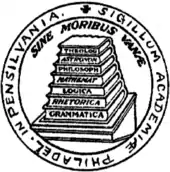
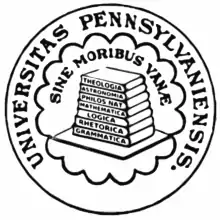
The official seal of the Trustees of the University of Pennsylvania serves as the signature and symbol of authenticity on documents issued by the corporation.[105] A request for one was first recorded in a meeting of the trustees in 1753 during which some of the Trustees "desired to get a Common Seal engraved for the Use of [the] Corporation". However, it was not until a meeting in 1756 that "a public Seal for the College with a proper device and Motto" was requested to be engraved in silver.[106] The most recent design, a modified version of the original seal, was approved in 1932, adopted a year later and is still used for much of the same purposes as the original.[105]
The outer ring of the current seal is inscribed with "Universitas Pennsylvaniensis", the Latin name of the University of Pennsylvania. The inside contains seven stacked books on a desk with the titles of subjects of the trivium and a modified quadrivium, components of a classical education: Theolog[ia], Astronom[ia], Philosoph[ia], Mathemat[ica], Logica, Rhetorica and Grammatica. Between the books and the outer ring is the Latin motto of the university, "Leges Sine Moribus Vanae".[105]
Campus
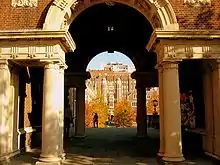
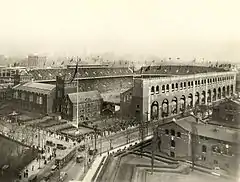
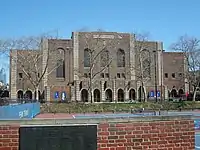
Much of Penn's architecture was designed by the Philadelphia-based architecture firm Cope and Stewardson (same architects who designed Princeton University and a large part of Washington University in St. Louis) known for having combined the Gothic architecture of the University of Oxford and University of Cambridge with the local landscape to establish the Collegiate Gothic style.[107]

The present core campus covers over 299 acres (121 ha) in a contiguous area of West Philadelphia's University City section, whereas the older heart of the campus comprises the University of Pennsylvania Campus Historic District. All of Penn's schools and most of its research institutes are located on this campus.

The surrounding neighborhood includes several restaurants, bars, a large upscale grocery store, and movie theater on the western edge of campus. Penn's core campus borders Drexel University and is a few blocks from the University City campus of Saint Joseph's University (which absorbed University of the Sciences in Philadelphia via merger) and The Restaurant School at Walnut Hill College. The renowned cancer research center Wistar Institute is also located on campus. In 2014, a new 7-story glass and steel building was completed next to the institute's original brick edifice built in 1897 further expanding collaboration between the university and the Wistar Institute.[108]
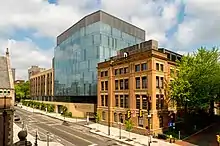
The Module 6 Utility Plant and Garage at Penn was designed by BLT Architects and completed in 1995. Module 6 is located at 38th and Walnut and includes spaces for 627 vehicles, 9,000 sq ft (840 m2) of storefront retail operations, a 9,500-ton chiller module and corresponding extension of the campus chilled water loop, and a 4,000-ton ice storage facility.[109]
In 2010, in its first significant expansion across the Schuylkill River, Penn purchased 23 acres (9.3 ha) at the northwest corner of 34th Street and Grays Ferry Avenue, the then site of DuPont Marshall Research Labs. In October 2016, Penn completed the design (with help from architects Matthias Hollwich, Marc Kushner, and KSS Architects) and renovation of the center piece of the project, a former paint factory it named Pennovation Works. Pennovation Works houses shared desks, wet labs, common areas, a "pitch bleacher," and other attributes of a tech incubator. The rest of the site, which Penn is formally calling "South Bank" (of Schuylkill River), is a mixture of lightly refurbished industrial buildings that serve as affordable and flexible workspaces and land for future development. Penn hopes that "South Bank will provide a place for academics, researchers, and entrepreneurs to establish their businesses in close proximity to each other to facilitate cross-pollination of their ideas, creativity, and innovation.[110]
Parks and arboreta
In 2007, Penn acquired about 35 acres (14 ha) between the campus and the Schuylkill River (the former site of the Philadelphia Civic Center and a nearby 24-acre (9.7 ha) site owned by the United States Postal Service). Dubbed the Postal Lands, the site extends from Market Street on the north to Penn's Bower Field on the south, including the former main regional U.S. Postal Building at 30th and Market Streets, now the regional office for the U.S. Internal Revenue Service. Over the next decade, the site became the home to educational, research, biomedical, and mixed-use facilities. The first phase, comprising a park and athletic facilities, opened in the fall of 2011.
In September 2011, Penn completed the construction of the $46.5 million, 24-acre (9.7 ha) Penn Park, which features passive and active recreation and athletic components framed and subdivided by canopy trees, lawns, and meadows. It is located east of the Highline Green and stretches from Walnut Street to South Streets.
Penn maintains two arboreta. The roughly 300-acre (120 ha) The Penn Campus Arboretum at the University of Pennsylvania encompasses the entire University City campus. The campus arboretum is an urban forest with over 6,500 trees representing 240 species of trees and shrubs, ten specialty gardens and five urban parks,[111] which has been designated as a Tree Campus USA[112] since 2009 and formally recognized as an accredited ArbNet Arboretum since 2017.[111] Penn maintains an interactive website linked to Penn's comprehensive tree inventory, which allows users to explore Penn's entire collection of trees.[113]

Penn also owns and operates the 92-acre (37 ha) Morris Arboretum in Chestnut Hill in northwestern Philadelphia. The Morris Arboretum is also the official arboretum of the Commonwealth of Pennsylvania.[111]
New Bolton Center veterinary campus
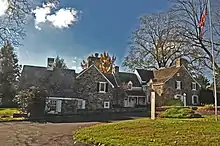
Penn also owns the 687-acre (278 ha) New Bolton Center, the research and large-animal health care center of its veterinary school.[114] Located near Kennett Square, New Bolton Center received nationwide media attention when Kentucky Derby winner Barbaro underwent surgery at its Widener Hospital for injuries suffered while running in the Preakness Stakes.[115]
Libraries
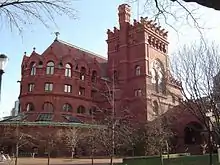
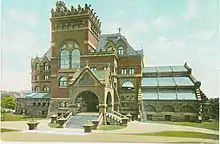
Penn's library began in 1750 with a donation of books from cartographer Lewis Evans. Twelve years later, then-provost William Smith sailed to England to raise additional funds to increase the collection size. Benjamin Franklin was one of the libraries' earliest donors and, as a trustee, saw to it that funds were allocated for the purchase of texts from London, many of which are still part of the collection, more than 250 years later.
Penn library system has grown into a system of 15 libraries (13 are on the contiguous campus) with 400 full-time equivalent (FTE) employees and a total operating budget of more than $48 million.[116] The library system has 6.19 million book and serial volumes as well as 4.23 million microform items and 1.11 million e-books.[10] It subscribes to over 68,000 print serials and e-journals.[117][118]
Penn has the following fifteen libraries located on campus, associated by school or subject area: (1) Annenberg (School of Communications), located in the Annenberg School; (2) Biddle (Law), located in the Law School; (3) Biomedical, located adjacent to the Robert Wood Johnson Pavilion of the Medical School; (4) Chemistry, located in the 1973 Wing of the Chemistry Building; (5) Dental Medicine; (6) Engineering, located on the second floor of the Towne Building in the Engineering School; (7) Fine Arts, located within the Fisher Fine Arts Library; (8) Katz Center for Advanced Judaic Studies, located at 420 Walnut Street, near Independence Hall and Washington Square; (9) Lea Library, located within the Van Pelt Library; (10) Lippincott (Wharton School), located on the second floor of the Van Pelt-Dietrich Library Center; (11) Math/Physics/Astronomy, located on the third floor of David Rittenhouse Laboratory; (12) Museum (Archaeology); (13) Rare Books and Manuscripts; (14) Van Pelt-Dietrich Library Center (Humanities and Social Sciences) – location of Weigle Information Commons; (15) Veterinary Medicine, located in Penn Campus (and two libraries located off campus (i) library at New Bolton Center and (ii) a High Density Storage facility).
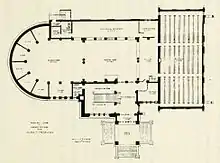
The Fine Arts Library was built to be Penn's main library (and first to have its own building). The then main library was designed by Frank Furness to be first library in nation to separate the low ceilings of the library stack, where the books were stored, from forty foot plus high ceilinged rooms, where the books were read and studied.[119][120][121]

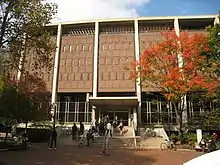
The Yarnall Library of Theology, a major American rare book collection, is part of Penn's libraries. The Yarnall Library of Theology was formerly affiliated with St. Clement's Church in Philadelphia. It was founded in 1911 under the terms of the wills of Ellis Hornor Yarnall (1839–1907) and Emily Yarnall, and subsequently housed at the former Philadelphia Divinity School. The library's major areas of focus are theology, patristics, and the liturgy, history and theology of the Anglican Communion and the Episcopal Church in the United States of America. It includes a large number of rare books, incunabula, and illuminated manuscripts, and new material continues to be added.[122][123]
Art installations
The campus has more than 40 notable art installations, in part because of a 1959 Philadelphia ordinance requiring total budget for new construction or major renovation projects (where any governmental resources are used) to include 1% for art (Philadelphia's ordinance created the first such program in the country)[124] to be used to pay for installation of site-specific public art,[125] in part because of many alumni who collect and donate art to Penn, and in part because of the presence of the University of Pennsylvania School of Design on campus.[126]
In 2020, Penn installed Brick House, a monumental work of art (a "critical fabulation" in language used by its creator, Simone Leigh) at the College Green gateway to Penn's campus (near corner of 34th Street and Woodland Walk).
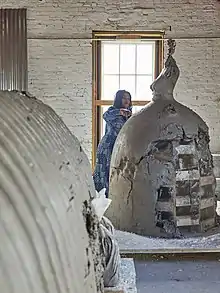
This 5,900-pound (2,700 kg) bronze sculpture, which is 16 feet (4.9 m) high and 9 feet (2.7 m) in diameter at its base, depicts an African woman's head (crowned with an afro framed by cornrow braids) atop a form that resembles both a skirt and a clay house.[127] At the installation, Penn president Amy Guttman proclaimed that "Ms. Leigh's sculpture brings a striking presence of strength, grace, and beauty—along with an ineffable sense of mystery and resilience—to a central crossroad of Penn's campus."[128]
The Covenant, better known to the student body as "Dueling Tampons"[129][130] or "The Tampons",[131] is a large red structure created by Alexander Liberman and located on Locust Walk as a gateway to the high-rise residences "super block". It was installed in 1975 and is made of rolled sheets of milled steel.

A larger-than-life white button, known as The Button (officially Split Button) is a modern art sculpture designed by designed by Swedish sculptor Claes Oldenburg (who specialized in creating oversize sculptures of everyday objects). It sits at the south entrance of Van Pelt Library and has button holes large enough for people to stand inside. Penn also has a replica of the Love sculpture, part of a series created by Robert Indiana. It is a painted aluminum sculpture and was installed in 1998 overlooking College Green.[126]
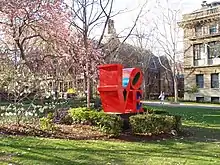
In 2019, the Association for Public Art loaned Penn[133] two multi-ton sculptures.[134] The two works are Social Consciousness[135][133] (created by Sir Jacob Epstein in 1954 and sited on the walkway between Wharton's Lippincott Library and Phi Phi chapter of Alpha Chi Rho fraternity house) and Atmosphere and Environment XII (created by Louise Nevelson in 1970, which is sited on Shoemaker Green between Franklin Field and Ringe Squash Courts).[136]
In addition to the contemporary art, Penn also has a number of more traditional statues including a good number created by Penn's first Director of Physical Education Department, R. Tait McKenzie.[137] Among the notable sculptures is that of Young Ben Franklin, which McKenzie produced and Penn sited adjacent to the fieldhouse contiguous to Franklin Field. The sculpture is titled Benjamin Franklin in 1723 and was created by McKenzie during the pre-World War 1 era (1910–1914). Other sculptures he produced for Penn include the 1924 sculpture of then Penn provost Edgar Fahs Smith.
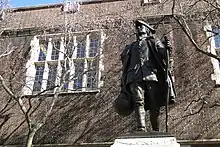
Penn is presently re-evaluating all of its public art and has formed a Campus Iconography Group led by Penn Design dean Frederick Steiner, who was part of a similar effort at the University of Texas at Austin (that led to the removal of statues of Jefferson Davis and other Confederate officials), and Penn's Chief Diversity Officer, Joann Mitchell. Penn has begun the process of adding art and removing or relocating art.[138] Penn removed from campus in 2020 the statue of the Reverend George Whitefield (who had inspired the 1740 establishment of a trust to establish a charity school, which trust Penn legally assumed in 1749) when research showed Whitefield owned fifty enslaved people and drafted and advocated for the key theological arguments in favor of slavery in Georgia and the rest of the Thirteen Colonies.[139]
The Penn Museum
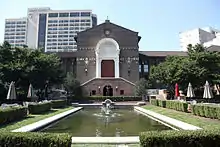
Since the Penn Museum was founded in 1887,[140] it has taken part in 400 research projects worldwide.[141] The museum's first project was an excavation of Nippur, a location in current day Iraq.[142]
Penn Museum is home to the largest authentic sphinx in North America at about seven feet high, four feet wide, 13 feet long, and 12.9 tons (made of solid red granite).
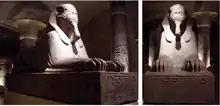
The sphinx was discovered in 1912 by the British archeologist, Sir William Matthew Flinders Petrie, during an excavation of the ancient Egyptian city of Memphis, Egypt, where the sphinx had guarded a temple to ward off evil. Since Petri's expedition was partially financed by Penn Petrie offered it to Penn, which arranged for it to be moved to museum in 1913. The sphinx was moved in 2019 to a more prominent spot intended to attract visitors.[143]
The museum has three gallery floors with artifacts from Egypt, the Middle East, Mesoamerica, Asia, the Mediterranean, Africa and indigenous artifacts of the Americas.[141] Its most famous object is the goat rearing into the branches of a rosette-leafed plant, from the royal tombs of Ur.
The Penn Museum's excavations and collections foster a strong research base for graduate students in the Graduate Group in the Art and Archaeology of the Mediterranean World. Features of the Beaux-Arts building include a rotunda and gardens that include Egyptian papyrus.
Other Penn museums, galleries, and art collections
.JPG.webp)
Penn maintains a website providing a detailed roadmap to small museums and galleries and over one hundred locations across campus where the public can access Penn's over 8,000 artworks acquired over 250 years and includes, but is not limited to, paintings, sculptures, photography, works on paper, and decorative arts.[144] The largest of the art galleries is the Institute of Contemporary Art, one of the only kunsthalles in the country, which showcases various art exhibitions throughout the year. Since 1983 the Arthur Ross Gallery, located at the Fisher Fine Arts Library, has housed Penn's art collection[145] and is named for its benefactor, philanthropist Arthur Ross.
Residences
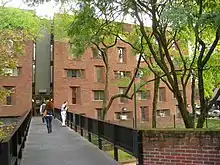
Every College House at the University of Pennsylvania has at least four members of faculty in the roles of House Dean, Faculty Master, and College House Fellows.[146] Within the College Houses, Penn has nearly 40 themed residential programs for students with shared interests such as world cinema or science and technology. Many of the nearby homes and apartments in the area surrounding the campus are often rented by undergraduate students moving off campus after their first year, as well as by graduate and professional students.
The College Houses include W.E.B. Du Bois, Fisher Hassenfeld, Gregory, Harnwell, Harrison, Hill College House, Kings Court English, Lauder College House, Riepe, Rodin, Stouffer, and Ware. The first College House was Van Pelt College House, established in the Fall of 1971. It was later renamed Gregory House.[147] Fisher Hassenfeld, Ware and Riepe together make up one building called "The Quad".

In 2019, Penn announced the construction of New College House West, which is planned to open in the fall of 2021.[149]
Penn students in Junior or Senior year may live in the 45 sororities and fraternities governed by three student-run governing councils, Interfraternity Council,[150] Intercultural Greek Council, and Panhellenic Council.[151]
_-_University_of_Pennsylvania_-_IMG_6638.jpg.webp)
Campus police
The University of Pennsylvania Police Department (UPPD) is the largest, private police department in Pennsylvania, with 117 members. All officers are sworn municipal police officers and retain general law enforcement authority while on the campus.[152]
Academics and interdisciplinary focus
| School | Year founded |
|---|---|
| Perelman School of Medicine | 1765[154] |
| School of Engineering and Applied Science | 1850[155] |
| Law School | 1850[note 3] |
| School of Design | 1868 |
| School of Dental Medicine | 1878[157] |
| The Wharton School | 1881[158] |
| Graduate School of Arts and Sciences | 1881[159] |
| School of Veterinary Medicine | 1884[160] |
| School of Social Policy and Practice | 1908 |
| Graduate School of Education | 1915 |
| School of Nursing | 1935 |
| Annenberg School for Communication | 1958 |
Penn's "One University Policy" allows students to enroll in classes in any of Penn's twelve schools.[161] The College of Arts and Sciences is the undergraduate division of the School of Arts and Sciences. The School of Arts and Sciences also contains the Graduate Division and the College of Liberal and Professional Studies, which is home to the Fels Institute of Government, the master's programs in Organizational Dynamics, and the Environmental Studies (MES) program. Wharton is the business school of the University of Pennsylvania. Other schools with undergraduate programs include the School of Nursing and the School of Engineering and Applied Science (SEAS).
Penn has a strong focus on interdisciplinary learning and research. It offers double degree programs, unique majors, and academic flexibility. Penn's "One University" policy allows undergraduates access to courses at all of Penn's undergraduate and graduate schools except the medical, veterinary and dental schools. Undergraduates at Penn may also take courses at Bryn Mawr, Haverford, and Swarthmore under a reciprocal agreement known as the Quaker Consortium.
Admissions
Undergraduate admissions to the University of Pennsylvania is considered by US News to be "most selective". Admissions officials consider a student's GPA to be a very important academic factor, with emphasis on an applicant's high school class rank and letters of recommendation.[162]
For the class of 2025, entering in the fall of 2021, the university received 56,333 applications and admitted 5.68 percent of the applicants.[163] The Atlantic also ranked Penn among the 10 most selective schools in the country. At the graduate level, based on admission statistics from U.S. News & World Report, Penn's most selective programs include its law school, the health care schools (medicine, dental medicine, nursing, veterinary), and Wharton business school.
| 2020[164] | 2019[165] | 2018[166] | 2017[167] | |
|---|---|---|---|---|
| Applicants | 42,205 | 44,961 | 44,491 | 40,413 |
| Admits | 3,404 | 3,446 | 3,740 | 3,757 |
| Admit rate | 8.07% | 7.66% | 8.41% | 9.30% |
| Enrolled | 2,321 | 2,400 | 2,518 | 2,456 |
| Yield | 68.18% | 69.65% | 67.33% | 65.37% |
| SAT range* | 1460-1570 | 1450–1560 | 1440–1560 | 1420–1560 |
| ACT range* | 33-35 | 33–35 | 32–35 | 32–35 |
* SAT and ACT ranges are from the 25th to the 75th percentile.
Coordinated dual-degree, accelerated, interdisciplinary programs
Penn offers unique and specialized coordinated dual-degree (CDD) programs, which selectively award candidates degrees from multiple schools at the university upon completion of graduation criteria of both schools in addition to program-specific programs and senior capstone projects. Additionally, there are accelerated and interdisciplinary programs offered by the university. These undergraduate programs include:
- Huntsman Program in International Studies and Business[168]
- Jerome Fisher Program in Management and Technology (M&T)[169]
- Roy and Diana Vagelos Program in Life Sciences and Management (LSM)[170]
- Nursing and Health Care Management (NHCM)[171]
- Roy and Diana Vagelos Integrated Program in Energy Research (VIPER)[172]
- Vagelos Scholars Program in Molecular Life Sciences (MLS)[173]
- Singh Program in Networked and Social Systems Engineering (NETS)[174]
- Digital Media Design (DMD)[175]
- Computer and Cognitive Science[176]
- Accelerated 7-Year Bio-Dental Program[177]
- Accelerated 6-Year Law and Medicine Program[178]
Dual-degree programs that lead to the same multiple degrees without participation in the specific above programs are also available. Unlike CDD programs, "dual degree" students fulfill requirements of both programs independently without the involvement of another program. Specialized dual-degree programs include Liberal Studies and Technology as well as an Artificial Intelligence: Computer and Cognitive Science Program. Both programs award a degree from the College of Arts and Sciences and a degree from the School of Engineering and Applied Sciences. Also, the Vagelos Scholars Program in Molecular Life Sciences allows its students to either double major in the sciences or submatriculate and earn both a BA and an MS in four years. The most recent Vagelos Integrated Program in Energy Research (VIPER) was first offered for the class of 2016. A joint program of Penn's School of Arts and Sciences and the School of Engineering and Applied Science, VIPER leads to dual Bachelor of Arts and Bachelor of Science in Engineering degrees by combining majors from each school.
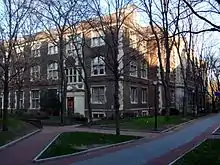
For graduate programs, Penn offers many formalized double degree graduate degrees such as a joint J.D./MBA and maintains a list of interdisciplinary institutions, such as the Institute for Medicine and Engineering, the Joseph H. Lauder Institute for Management and International Studies, and the Institute for Research in Cognitive Science.
The University of Pennsylvania School of Social Policy and Practice, commonly known as Penn SP2, is a school of social policy and social work that offers degrees in a variety of subfields, in addition to several dual degree programs and sub-matriculation programs.[179][180][181] Penn SP2's vision is: "The passionate pursuit of social innovation, impact and justice."[182]
Originally named the School of Social Work, SP2 was founded in 1908 and is a graduate school of the University of Pennsylvania. The school specializes in research, education, and policy development in relation to both social and economic issues.[183][184]
The School of Veterinary Medicine offers five dual-degree programs, combining the Doctor of Veterinary Medicine (VMD) with a Master of Social Work (MSW), Master of Environmental Studies (MES), Doctor of Philosophy (PhD), Master of Public Health (MPH) or Masters in Business Administration (MBA) degree. The Penn Vet dual-degree programs are meant to support veterinarians planning to engage in interdisciplinary work in the areas of human health, environmental health, and animal health and welfare.[185]
Academic medical center and biomedical research complex
.tif.jpg.webp)
In 2018, the university's nursing school was ranked number one by Quacquarelli Symonds.[186] That year, Quacquarelli Symonds also ranked Penn's school of Veterinary Medicine sixth.[187] In 2019, the Perelman School of Medicine was named the third-best medical school for research in U.S. News & World Report's 2020 ranking.[188]
The University of Pennsylvania Health System (also known as UPHS) is a multi-hospital health system headquartered in Philadelphia, Pennsylvania, owned by Trustees of University of Pennsylvania. UPHS and the Perelman School of Medicine at the University of Pennsylvania together comprise Penn Medicine, a clinical and research entity of the University of Pennsylvania. UPHS hospitals include the Hospital of the University of Pennsylvania,[189] Penn Presbyterian Medical Center, Pennsylvania Hospital, Chester County Hospital, Lancaster General Hospital, and Princeton Medical Center.[190] Penn Medicine owns and operates the first hospital in the United States, the Pennsylvania Hospital.[191] It is also home to America's first surgical amphitheatre[192] and its first medical library.[193]
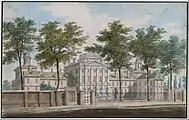 The Pennsylvania Hospital as painted by Pavel Svinyin in 1811
The Pennsylvania Hospital as painted by Pavel Svinyin in 1811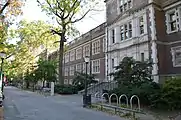 Perelman School of Medicine
Perelman School of Medicine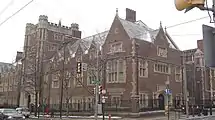 Penn School of Dental Medicine
Penn School of Dental Medicine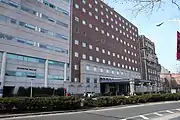 Hospital of the University of Pennsylvania (facing northwest towards front entrance)
Hospital of the University of Pennsylvania (facing northwest towards front entrance)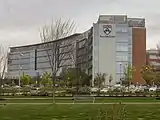 Penn owned Princeton Medical Center, eastern facade
Penn owned Princeton Medical Center, eastern facade
Research, innovations and discoveries
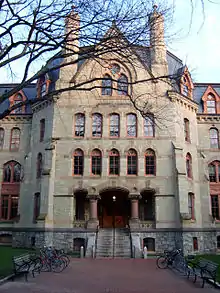

Penn is classified as an "R1" doctoral university: "Highest research activity."[194] Its economic impact on the Commonwealth of Pennsylvania for 2015 amounted to $14.3 billion.[195] Penn's research expenditures in the 2018 fiscal year were $1.442 billion, the fourth largest in the U.S.[196] In fiscal year 2019 Penn received $582.3 million in funding from the National Institutes of Health.[197]
In line with its well-known interdisciplinary tradition, Penn's research centers often span two or more disciplines. In the 2010–2011 academic year alone, five interdisciplinary research centers were created or substantially expanded; these include the Center for Health-care Financing,[198] the Center for Global Women's Health at the Nursing School,[199] the $13 million Morris Arboretum's Horticulture Center,[200] the $15 million Jay H. Baker Retailing Center at Wharton[201] and the $13 million Translational Research Center at Penn Medicine.[202] With these additions, Penn now counts 165 research centers hosting a research community of over 4,300 faculty and over 1,100 postdoctoral fellows, 5,500 academic support staff and graduate student trainees.[10] To further assist the advancement of interdisciplinary research President Amy Gutmann established the "Penn Integrates Knowledge" title awarded to selected Penn professors "whose research and teaching exemplify the integration of knowledge".[203] These professors hold endowed professorships and joint appointments between Penn's schools.
Penn is also among the most prolific producers of doctoral students. With 487 PhDs awarded in 2009, Penn ranks third in the Ivy League, only behind Columbia and Cornell (Harvard did not report data).[204] It also has one of the highest numbers of post-doctoral appointees (933 in number for 2004–2007), ranking third in the Ivy League (behind Harvard and Yale) and tenth nationally.[205]
In most disciplines Penn professors' productivity is among the highest in the nation and first in the fields of epidemiology, business, communication studies, comparative literature, languages, information science, criminal justice and criminology, social sciences and sociology.[206] According to the National Research Council nearly three-quarters of Penn's 41 assessed programs were placed in ranges including the top 10 rankings in their fields, with more than half of these in ranges including the top five rankings in these fields.[207]
Penn's research tradition has historically been complemented by innovations that shaped higher education. In addition to establishing the first medical school, the first university teaching hospital, the first business school, and the first student union, Penn was also the cradle of other significant developments. In 1852, Penn Law was the first law school in the nation to publish a law journal still in existence (then called The American Law Register, now the Penn Law Review, one of the most cited law journals in the world).[208] Under the deanship of William Draper Lewis, the law school was also one of the first schools to emphasize legal teaching by full-time professors instead of practitioners, a system that is still followed today.[209] The Wharton School was home to several pioneering developments in business education. It established the first research center in a business school in 1921 and the first center for entrepreneurship center in 1973[210] and it regularly introduced novel curricula for which BusinessWeek wrote, "Wharton is on the crest of a wave of reinvention and change in management education".[211][212]
Several major scientific discoveries have also taken place at Penn. The university is probably best known as the place where the first general-purpose electronic computer (ENIAC) was born in 1946 at the Moore School of Electrical Engineering.[213] It was here also where the world's first spelling and grammar checkers were created, as well as the popular COBOL programming language.[213] Penn can also boast some of the most important discoveries in the field of medicine. The dialysis machine used as an artificial replacement for lost kidney function was conceived and devised out of a pressure cooker by William Inouye while he was still a student at Penn Med;[214] the Rubella and Hepatitis B vaccines were developed at Penn;[214] the discovery of cancer's link with genes, cognitive therapy, Retin-A (the cream used to treat acne), Resistin, the Philadelphia gene (linked to chronic myelogenous leukemia) and the technology behind PET Scans were all discovered by Penn Med researchers.[214] More recent gene research has led to the discovery of the (a) genes for fragile X syndrome, the most common form of inherited mental retardation; (b) spinal and bulbar muscular atrophy, a disorder marked by progressive muscle wasting; (c) Charcot–Marie–Tooth disease, a progressive neurodegenerative disease that affects the hands, feet and limbs;[214] and (d) genetically engineered T cells used to treat lymphoblastic leukemia and refractory diffuse large B cell lymphoma.[215][216]
Conductive polymer was also developed at Penn by Alan J. Heeger, Alan MacDiarmid and Hideki Shirakawa, an invention that earned them the Nobel Prize in Chemistry. On faculty since 1965, Ralph L. Brinster developed the scientific basis for in vitro fertilization and the transgenic mouse at Penn and was awarded the National Medal of Science in 2010. The theory of superconductivity was also partly developed at Penn, by then-faculty member John Robert Schrieffer (along with John Bardeen and Leon Cooper). The university has also contributed major advancements in the fields of economics and management. Among the many discoveries are conjoint analysis, widely used as a predictive tool especially in market research, Simon Kuznets's method of measuring Gross National Product,[217] the Penn effect (the observation that consumer price levels in richer countries are systematically higher than in poorer ones) and the "Wharton Model"[218] developed by Nobel-laureate Lawrence Klein to measure and forecast economic activity. The idea behind Health Maintenance Organizations also belonged to Penn professor Robert Eilers, who put it into practice during then-President Nixon's health reform in the 1970s.[217]
Academic profile and rankings
International partnerships
Students can study abroad for a semester or a year at partner institutions such as the London School of Economics, University of Edinburgh, Chinese University of Hong Kong, University of Melbourne, Sciences Po, University of Queensland, University College London, King's College London, Hebrew University of Jerusalem and ETH Zurich.
Rankings
|
|
| ||||||||||||||||||||||||||||||||||||||||||||||||||||||||||||||||||||||||||||||||||||||||||||||||||||||||||||||||||||||||||||||||||||||||||||||||||||||
U.S. News & World Report's 2022 rankings place Penn 7th among national universities in the United States[231][232] and Center for World University Rankings' ("CWUR") 2020/2021 survey also ranks Penn as the 8th best university in the world.[233] The Princeton Review included Penn in its Dream Colleges list in 2015.[234] As reported by USA Today, Penn was ranked 1st in the United States by College Factual for 2015.[235]
In their 2021 edition, Penn was ranked 10th in the nation by QS (Quacquarelli Symonds).[236] In the 2020 edition, Penn was ranked 15th in the world by the QS World University Rankings[237] and in 2019, 17th by the Academic Ranking of World Universities (ARWU) and 12th by the Times Higher Education World University Rankings. In 2019, it ranked 12th among the universities around the world by SCImago Institutions Rankings.[238] According to the 2015 ARWU ranking, Penn is also the 8th- and 9th-best university in the world for economics/business and social sciences studies, respectively.[239] University of Pennsylvania ranked 12th among 300 Best World Universities in 2012 compiled by Human Resources & Labor Review (HRLR) on Measurements of World's Top 300 Universities Graduates' Performance.[240]
The Center for Measuring University Performance places Penn in the first tier of the United States' top research universities (tied with Columbia, MIT and Stanford), based on research expenditures, faculty awards, PhD granted and other academic criteria.[241] Penn was also ranked 18th of all U.S. colleges and universities in terms of R&D expenditures in fiscal year 2013 by the National Science Foundation.[242] The High Impact Universities research performance index ranks Penn 8th in the world, whereas the 2010 Performance Ranking of Scientific Papers for World Universities (published by the Higher Education Evaluation and Accreditation Council of Taiwan) ranks Penn 11th in the world for 2007,[243] 2008[244] and 2010[245] and 9th for 2009.[246]
The Performance Ranking of Scientific Papers measures universities' research productivity, research impact, and research excellence based on the scientific papers published by their academic staff. The SCImago Institutions Rankings World Report 2012, which ranks world universities, national institutions and academies in terms of research output, ranks Penn 7th nationally among U.S. universities (2nd in the Ivy League behind Harvard) and 28th in the world overall (the first being France's Centre National de la Recherche Scientifique).[247]
The Mines ParisTech International Professional Ranking, which ranks universities on the basis of the number of alumni listed among CEOs in the 500 largest worldwide companies, ranks Penn 11th worldwide and 2nd nationally behind Harvard.[248] According to a U.S. News article in 2010, Penn is tied for second (tied with Dartmouth College and Tufts University) for the number of undergraduate alumni who are current Fortune 100 CEOs.[249] Forbes ranked Penn 17th, based on a variety of criteria.[250] In 2022, Poets & Quants ranked the undergraduate Wharton business school as the top business school in the nation for the fifth year in a row.[251]
Graduate and professional programs
Among its professional schools, the school of education was ranked number one in 2021 and Wharton School of Business was ranked number one in 2022,[252] the communication, dentistry, medicine, nursing, and veterinary medicine schools rank in the top 5 nationally.[253] Penn's Law School was ranked number 6 in 2022[254] and Design school, and its School of Social Policy and Practice are ranked in the top 10[253] In the 2010 QS Global 200 Business Schools Report, Penn was ranked 2nd in North America.[255]
Student life
| Ethnic enrollment, fall 2018[256] |
Number (percentage) of undergraduates |
|---|---|
| African American | 715 (7.1%) |
| Native American | 12 (0.1%) |
| Asian American and Pacific Islander |
2,084 (20.7%) |
| Hispanic and Latino American |
1,044 (10.4%) |
| White | 4,278 (42.6%) |
| International | 1,261 (12.6%) |
| Two or more races, non-Hispanic |
460 (4.6%) |
| Unknown | 179 (1.8%) |
| Total | 10,033 (100%) |
Demographics and diversity
Jonathan and Philip Gayienquitioga, two brothers of the Mohawk Nation,[257] were recruited by Benjamin Franklin to attend the Academy of Philadelphia, making them the first Native Americans at Penn when they enrolled in 1755.[258] Moses Levy, the first Jewish student, enrolled in 1769 (and was also elected Penn's first Jewish trustee in 1802, serving to 1826).[259] Joseph M. Urquiola, School of Medicine (Penn Med) class of 1829 was the first Latino (from Cuba),[83][260][261] and Auxencio Maria Pena, School of Medicine (Penn Med) class of 1836, was first South American (from Venezuela)[262] to graduate from Penn.
William Adger, James Brister, and Nathan Francis Mossell in 1879 were the first African Americans to enroll at Penn. Adger was the first African American to graduate from the college at Penn (1883),[263] and when Brister graduated from the School of Dental Medicine (Penn Dental) (class of 1881), he was the first African American to earn a degree at Penn.[264] Mossell was first African American to graduate from Penn Med (1882)[265] (and had a brother, Aaron Albert Mossell II who was the first African American graduate of University of Pennsylvania Law School (in 1888) and [266] niece, Sadie Tanner Mossell Alexander, Albert's daughter, who not only was first African American woman to graduate from Penn Law (in 1927) and be admitted to practice law in Pennsylvania, but prior to such noteworthy accomplishments was first African American woman to earn a PhD in the United States (from Penn in 1922)).[267]
Tosui Imadate was the first person of Asian descent to graduate from Penn (College, B.S. 1879).[268] In 1877, Imadate became the first Asian member of a fraternity at Penn when he became a brother at Phi Kappa Psi.[269] In a quote from a portion of a letter published in December 1880 issue of The Crescent, Imadate is described by a Phi Kappa Psi brother as a "brother member of Penn's I [iota] chapter of Phi Kappa Psi Fraternity, who is a professor in college at Kiota [(Kyoto, Japan)]".[270][271] Fuji Tsukamoto (Penn Graduate School Class of 1899) became the first woman of Asian descent to matriculate at Penn when she started her study of biology and botany in 1885 and, like Tosui Imadate, also taught at Kyoto college in Japan.[272]
Mary Alice Bennett, MD, PhD, and Anna H. Johnson were in 1880 the first women to enroll in a Penn degree-granting program and Bennett was the first woman to receive a degree from Penn, which was a PhD.[273][274][83]

Julian Abele ("Willing and Able" to his fellow students) in 1902 was the first African American to graduate from University of Pennsylvania School of Design (then named Department of Architecture) and was elected as the president of Penn's Architectural Society.[275] Abele won a 1901 student competition where he designed a Beaux Arts pedestrian gateway that was built and still stands on the campus of Haverford College,[276] The Edward B. Conklin Memorial Gate at the Railroad Avenue entrance to Haverford College.[277] Abele contributed to the design of more than 400 buildings, including the Widener Memorial Library at Harvard University (1912–1915), Philadelphia's Central Library (1917–1927),[278] and the Philadelphia Museum of Art (1914–1928).[279] and was the primary designer of the west campus of Duke University (1924–1954).[280] Duke honored Abele by prominently displaying his portrait, the first portrait of an African American to be displayed on the campus.[281]
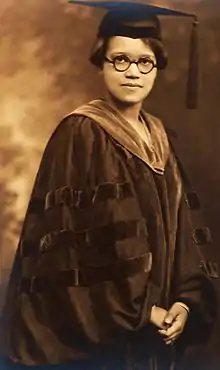
Sadie Tanner Mossell Alexander (niece of Nathan Francis Mossell) was the first African American to receive a PhD in economics in the United States (and third black woman to earn one in the United States in any subject)[282] and first from Penn in 1921, the first African-American woman to receive a law degree from Penn Law in 1927, and the first African-American woman to practice law in Pennsylvania.[267]

Alan L. Hart, MD, who earned a master's degree at Penn Med in radiology (class of 1928),[283][note 4] was born in 1890 and publicly identified as a female, Alberta Lucille Hart, through much of 1917, the year Dr. Hart transitioned to being a man by having a hysterectomy, one of the first in the United States to be performed to help a person become a trans man, and lived the rest of his life as a man.[284] Dr. Hart, Penn's most prominent transgender alumnus in the first half of the twentieth century, was a pioneer in using x-ray photography to detect tuberculosis, allowing the identification of asymptomatic TB carriers (seventy-five percent of the total infected), permitting treatment of patients before they had complications, and allowing for separation of TB patients from others to stop the spread of one of the more infectious deadly diseases known to humanity.[283]
The first openly LGBTQ+ organization funded by Penn was formed in 1972 by "Steve" Kiyoshi Kuromiya (a Benjamin Franklin scholar and Penn alumnus from college class of 1966) when he created the Gay Coffee Hour, which met every week on campus and was also open to non-students and served as an alternative space to gay bars for gay people of all ages.[285] Penn funded the Gay Coffee House program (via a grant from the student government), which was held in Houston Hall at six o'clock in the evening every Wednesday and attracted, on average, roughly sixty people of all ages with roughly "one-quarter to one-third women and two-thirds to three-quarters men."[286]
As detailed in part above, by the first decades of the twentieth century, Penn made strides and took an active interest in attracting diverse students from around the globe. Two examples of such action occurred in 1910. Penn's first director of publicity, created a recruiting brochure, translated into Spanish, with approximately 10,000 copies circulated throughout Latin America. That same year, the Penn-affiliated organization, the Cosmopolitan Club, started an annual tradition of hosting an opening "smoker", which attracted students from 40 nations who were formally welcomed to the university by then-vice provost Edgar Fahs Smith (who the following year would start a ten-year tenure as provost)[78][79][80][81][82] who spoke about how Penn wanted to "bring together students of different countries and break down misunderstandings existing between them".[83]
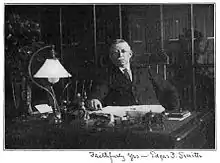
The success of such efforts were reported in 1921 when the official Penn publicity department reported that
We have an enrollment at the University of 12,000 students, who have registered from every State in the Union, and 253 students from at least fifty foreign countries and foreign territories, including India, South Africa, New Zealand, Australia and practically all the British possessions except Ireland; every Latin American country, and most of the Oriental and European nations.
— George E. Nitzsche, 1921[87]
Of those accepted for admission in 2018, 48 percent were Asian, Hispanic, African-American or Native American.[10] Fourteen percent of entering undergraduates in 2018 were international students.[10] The composition of international first-year students in 2018 was: 46% from Asia; 15% from Africa and the Middle East; 16% from Europe; 14% from Canada and Mexico; 8% from the Caribbean, Central America and South America; 5% from Australia and the Pacific Islands.[10] The acceptance rate for international students admission in 2018 was 493 out of 8,316 (6.7%).[10] In 2018, 55% of all enrolled students were women.[10]
In the last few decades, Jewish enrollment has been declining. Circa 1999 about 28% of the students were Jewish.[287] In early 2020, 1,750 Penn undergraduate students were Jewish,[288] which would be approximately 17%[289] of the some 10,000 undergrads for 2019–20.
Penn Face and behavioral health
The university's social pressure surrounding academic perfection, extreme competitiveness, and nonguaranteed readmission have created what is known as "Penn Face": students put on a façade of confidence and happiness while enduring mental turmoil.[290][291][292][293][294] Stanford University calls this phenomenon "Duck Syndrome."[293][295] In recent years, mental health has become an issue on campus with ten student suicides between the years of 2013 to 2016.[296] The school responded by launching a task force.[297][298] The most widely covered case of Penn Face has been Madison Holleran.[299][300] In 2018, initiatives were enacted to ameliorate mental health problems, such as requiring sophomores to live on campus and the daily closing of Huntsman Hall at 2:00 a.m.[301][302] The university's suicide rate was the catalyst for a 2018 state bill, introduced by Governor Tom Wolf, to raise Pennsylvania's standards for university suicide prevention.[303] The university's efforts to address mental health on campus came into the national spotlight again in September 2019 when the director of the university's counseling services died by suicide six months after starting the position.[304]
Selected student organizations
- Oldest organization
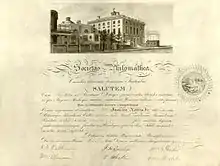
The Philomathean Society, founded in 1813, is one of the United States' oldest collegiate literary societies and continues to host lectures and intellectual events open to the public.[305]

- Self-funded organization
- The Daily Pennsylvanian
The Daily Pennsylvanian is an independent, student-run newspaper, which has been published daily since it was founded in 1885.[306] The newspaper went unpublished from May 1943 to November 1945 due to World War II.[306] In 1984, the university lost all editorial and financial control of The Daily Pennsylvanian (also known as The DP) when the newspaper became its own corporation.[306] The Daily Pennsylvanian has won the Pacemaker Award administered by the Associated Collegiate Press multiple times, most recently in 2019.[307][308] The DP also publishes a weekly arts and culture magazine called 34th Street Magazine.
The DP also operates three principal websites—thedp.com, 34st.com, and underthebutton.com—as well as a variety of opinion, news, and sports blogs. It has received various collegiate journalism awards.
- Academic organizations
The Penn Debate Society (PDS), founded in 1984 as the Penn Parliamentary Debate Society, is Penn's debate team, which competes regularly on the American Parliamentary Debate Association and the international British Parliamentary circuit.[309]
The Penn History Review is a journal, published twice a year, through the Department of History, for undergraduate historical research, by and for undergraduates, and founded in 1991.[310][311][312]
- LGBTQ+ organizations
Penn has been ranked as the number one LGBTQ+ friendly school in the country.[313] Penn's LGBTQ+ center is second oldest in the nation[314] and oldest in Commonwealth of Pennsylvania as it has been serving the LGBTQ+ community since 1979 by providing support and guidance through 25 groups (including Penn J-Bagel a Jewish LGBTQ+ group, the Lambda Alliance a general LGBTQ social organization, and oSTEM a group for LGBTQ people in STEM fields).[315] Penn offers courses in Sexuality and Gender Studies which allows students to discover and learn queer theory, history of sexual norms, and other gender orientation related courses.[316] The first Penn funded LGBTQ+ organization was formed in 1972 by "Steve" Kiyoshi Kuromiya (Penn college class of 1966) when he created the Gay Coffee Hour, which met every week on campus and served as an alternative space to gay bars for gay people of all ages.[285] Penn funded the Gay Coffee House via a grant from the student government and the weekly event was held in Houston Hall Wednesday evenings.[286]
Performing arts organizations
Penn is home to numerous organizations that promote the arts, from dance to spoken word, jazz to stand-up comedy, theatre, a cappella and more. The Performing Arts Council (PAC) oversees 45 student organizations in these areas.[317] The PAC has four subcommittees: A Cappella Council; Dance Arts Council; Singer, Musicians, and Comedians (SMAC); and Theatre Arts Council (TAC-e).
Penn Glee Club
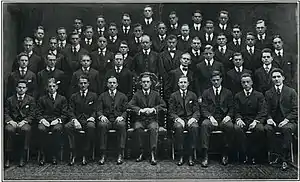
The University of Pennsylvania Glee Club, founded in 1862, is tied for fourth oldest continually running glee clubs in the United States[318] and the oldest performing arts group at the University of Pennsylvania. Each year, the Penn Glee Club writes and produces a fully staged, Broadway-style production with an eclectic mix of Penn standards, Broadway classics, classical favorites, and pop hits, highlighting choral singing from all genders (as of April 9, 2021, it merged[319] with Penn Sirens, a previously all female chorale group), clever plots and dialogue, dancing, humor, colorful sets and costumes, and a pit band.[320] The Glee Club draws its singing members from the undergraduate and graduate students (and men and women from the Penn community are also called upon to fill roles in the pit band and technical staff when the club is involved with theatrical productions). The Penn Glee Club has traveled to nearly all 50 states in the United States and over 40 nations and territories on five continents.[321] Since the 1950s, Penn Glee Club has appeared on national television with such celebrities as Bob Hope, Frank Sinatra, Jimmy Stewart, Ed McMahon, Carol Lawrence, and Princess Grace Kelly of Monaco and has been showcased on television specials such as the Macy's Thanksgiving Day Parade, and at professional sporting events for The Philadelphia Phillies where club sung the National Anthem at the 1993 National League Championship Series. Since its first performance at the White House for President Calvin Coolidge in 1926, the club has sung for numerous heads of state and world leaders. One of the highlights of 1989 was the club's performance for Polish President Lech Wałęsa. Bruce Montgomery, its best-known and longest-serving director, led the club from 1956 until 2000.[322]
Penn Band
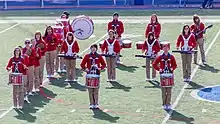

The University of Pennsylvania Band has been a part of student life since 1897.[323] The Penn Band presently mainly performs at football and basketball games as well as university functions (e.g. commencement and convocation) throughout the year but in past it was known not only as the first college band to perform at Macy's Thanksgiving Day Parade but performed with notable musicians, including John Philip Sousa, members of the Philadelphia Orchestra, the U.S. Marine Band ("The President's Own"), Doc Severinsen of The Tonight Show Starring Johnny Carson. Beginning in the late 1920s and 1930s Penn Band recorded with the Victor Talking Machine Company (RCA-Victor Company) and was nationally broadcast on WABC (AM). In 1977, Penn Band performed with Chuck Barris of The Gong Show and in 1980 opened for Penn Alumnus, Maury Povich in his eponymously named show.
Penn Band has performed for Princess Grace Kelly of Monaco (sister and aunt to number of alumni), alumnus and District Attorney and Mayor of Philadelphia, and Governor of Pennsylvania Ed Rendell, Vice President Al Gore, Presidents Theodore Roosevelt, Lyndon B. Johnson and Ronald Reagan, and Polish dissident and President Lech Wałęsa. By the 1970s, however, Penn Band had begun moving away from the traditional corps style and is now a scramble band. The first one hundred years of the organization's history was described in a book from Arcadia Publishing: Images of America:The University of Pennsylvania Band (2006).[323]
Penn's a cappella community

The A Cappella Council (ACK) is composed of 14 a cappella groups. Penn's a cappella groups entertain audiences with repertoires including pop, rock, R&B, jazz, Hindi, and Chinese songs.[324] ACK is also home to Off The Beat, which has received the most contemporary a cappella recording awards of any collegiate group in the United States and the most features on the Best of College A Cappella albums.[325] Penn Masala, formed in 1996, is world's oldest[326][327] and premier[328][329] South Asian a cappella group based in an American university, which has performed for Barack Obama, Henry Kissinger, Ban Ki Moon, Farooq Abdullah, Imran Khan, Rajkumar Hirani, A.R. Rahman, and Sunidhi Chauhan, had their a cappella version of Nazia Hassan's Urdu classic "Aap Jaisa Koi", (originally from the movie Qurbani) sung in the movie American Desi,[330] and was invited by Penn alumni Elizabeth Banks (class of 1996) and Max Handelman (Banks' husband, class of 1995) to appear in Pitch Perfect 2, as Banks reported that Penn's a capella community inspired the film series starring and/or produced by Banks and Handleman.[331]
Comedy organizations
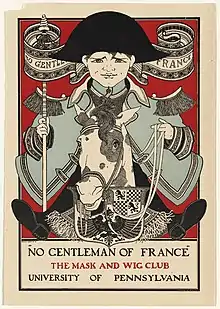
The Mask and Wig Club, founded in 1889, is the oldest all-male musical comedy troupe in the country. Bloomers comedy group, founded in 1978, was the "... nation's first collegiate all-women musical and sketch comedy troupe..."[333] and now accepts all persons from under-represented gender identities who perform comedy.[334][335]
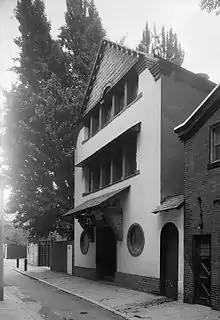
Religious and spiritual organizations
- Mainstream Protestantism
Dating back to 1857, The Christian Association (a.k.a. The CA) is the oldest religious organization at the university and is composed primarily of students from Mainline Protestant backgrounds.[336] When the university moved to its current campus in the 1880s the CA was based in Houston Hall. After moving around several times it relocated to building at 36th and Locust Streets, which it built and owned (now the ARCH Building), and occupied from 1928 until 2000. The CA ran several foreign missions including one of lasting import when in 1906 it financed University of Pennsylvania School of Medicine graduate, Josiah McCracken, MD, trip to China to investigate the viability of operating the medical department of the Canton Christian College (now known as Lingnan University (Guangzhou)). The following year, Dr. McCracken moved to China and renamed the department as "The University Medical School in Canton, China," and served as its president from the time of renaming through the date in 1913 when the CA ended its affiliation with the Canton Christian College.[337] The CA also ran for decades a camp for socio-economically disadvantaged children from Philadelphia in a more rural section of Pennsylvania.[338] At present the CA occupies part of the parsonage at Tabernacle United Church of Christ.[339]
- Judaism
Though Moses Levy, Penn's first Jewish student, enrolled in 1772 and first Jewish trustee was elected in 1802 (and served through 1826), organized Jewish life did not begin in earnest until start of 20th century.[340] Jewish Life on campus is centered at Penn branch of Hillel International,[341][289] which inspires students to explore Judaism, creates patterns of Jewish living that can be sustained after graduation, provides religious communities, promotes educational initiatives, social justice projects, social and cultural opportunities, and groups focusing on Israel education and politics, and hosts a Kosher Penn approved dining hall (supervised by the Community Kashrus of Greater Philadelphia). In addition Penn Hillel student and professional staff help facilitate the Rohr Jewish Learning Institute's Sinai Scholars Society Academic Symposium, a prestigious event that brings together Jewish college students with noted Jewish academics for a day of in-depth discussion and debate at the university.[342]
- Roman Catholicism
The Penn Newman Catholic Center (the Newman Center) was founded in 1893 (and was the first Newman Center in the country) with the mission of supporting students, faculty, and staff in their religious endeavors. The organization brings prominent Christian figures to campus, including Rev. Thomas "Tom" J. Hagan, OSFS, who worked in the Newman Center and founded Haiti-based non-profit Hands Together;[343] and, in September 2015, James Martin SJ (Wharton undergraduate class of 1982[344]). In addition to his duties as a Jesuit priest, Father Martin is an editor-at-large of the Jesuit magazine America,[345] a New York Times Best Selling author, and frequent commentator on the life and teachings of Jesus and on Ignatian spirituality. Father Martin is especially well known for his outreach to the LGBT community, which has drawn a strong backlash from parts of the Catholic Church, but has provided comfort to Penn students and other members of Roman Catholic community who wish to stay connected with their faith and identify as LGBQT.[346][347][348] During the 2015 World Meetings of Families, which included a visit from Pope Francis to Philadelphia, the Newman Center hosted over 900 Penn students and alumni.[349]
- Hinduism and Jainism
University of Pennsylvania funds (via the Graduate and Professional Student Assembly or similar undergraduate organization) a variety of official clubs focused on India including a number focused on students who are Hindu or Jain. In addition to 'Pan-Asian American Community House (PAACH)', a center for students to celebrate South Asian, East Asian, Southeast Asian, culture and religion,[350] 'Rangoli, the Indian Association at Penn', a Penn club, that educates and informs Penn students (mainly graduate and professional students) with ancestry and/or interest in India whose goals include a desire to "rekindle the spirit of various Indian traditions and festivals",[351] and 'Penn Masala', the first and now world famous South Asian a cappella group (detailed above under performing arts clubs), Penn funds the 'Penn Hindu & Jain Association', a student-run official club at Penn that has 80 to 110 student members and an extensive alumni network, dedicated to raise awareness of the Hindu and Jain faiths and foster further development of these communities in the greater Philadelphia area by providing a variety of services and hosting a number of events such as Holi Festival (which has been held annually at Penn since 1993[352][353][354]) and ". . . aims to be a home to anyone seeking to explore their spiritual, religious, or social interests."[355]
- Islam
In 1963, the Muslim Students' Association (MSA National) and Penn chapter of MSA National were founded to facilitate Muslim life among students on college campuses.[356][357] The University of Pennsylvania chapter (Penn MSA) was established to help Penn Muslims build faith and community by fostering a space under the guidance of Islamic principles.[358] In 1973, Penn MSA helped found Masjid Al-Jamia, a mosque close to campus, to facilitate Penn's and the local community's easy access to Islamic study circles, social events, Friday prayers and holiday celebrations.[359] The establishment of the mosque and the 1980 organization of a relief fund to aid refugees fleeing Afghanistan in the wake of the Soviet attack[360] are consistent with Penn MSA support of mission of its related umbrella organization, Islamic Society of North America, to "foster the development of the Muslim community, interfaith relations, civic engagement, and better understandings of Islam."[361] Though Penn MSA stakeholders remain involved with Masjid Al-Jamia mosque, the local West Philadelphia community now operates the mosque, which, as of 2009, is owned by a national organization, North American Islamic Trust, Inc.[362][359] In addition to Penn MSA support of Islam at Penn, The Muslim Life Program at the University of Pennsylvania provides such support and helped cause Penn (in January 2017) to hire its first full-time Muslim chaplain, the co-president of the Association of Campus Muslim Chaplains, Sister Patricia Anton (whose background includes working with Muslim, interfaith, academic and peace-building institutions such as Islamic Society of North America and Islamic Relief). Chaplain Anton's mandate includes supporting and guiding the Penn Muslim community to foster further development of such community by creating a welcoming environment that provides Penn Muslim community opportunities to intellectually and spiritually engage with Islam.[363] Penn also has a residential house, the Muslim Life Residential Program, which provides Penn students with a live/learn environment focused on the appreciation of Islamic culture, food, history, and practice, and shows its residents how Islam is deeply integrated in the culture of Philadelphia so they may appreciate how Islam influences daily life in the home of one of the largest Muslim communities in North America.[364]
Athletics
Penn's sports teams are nicknamed the Quakers, but the teams are often also referred to as The Red and Blue as reflected in the popular song sung after every athletic contest where the Penn Band or other musical groups are present.[365][366] The athletes participate in the Ivy League and Division I (Division I FCS for football) in the NCAA. In recent decades, they often have been league champions in football (14 times from 1982 to 2010) and basketball (22 times from 1970 to 2006). The first athletic team at Penn was the cricket team, which formed in 1842 and played regularly through 1846, the year it lost its "grounds", and then only played intermittently until 1864, the year it played its first intercollegiate game (against Haverford College).[367] The rowing (or crew) team composed of Penn students but not officially representing Penn was formed in 1854 but did not compete against other colleges as official part of Penn until 1879. The rugby football team began to play against other colleges, most notably against College of New Jersey (now Princeton University) in 1874 using a combination of association football (i.e. soccer) and rugby rules (the twenty players on each side were able to use their hands but were not able to pass or bat the ball forward).[368][369][370]
Cricket

The first University of Pennsylvania cricket team (reported to be the first cricket team in the United States comprised exclusively of Americans)[372] was organized in 1842 by a member of Philadelphia's prominent Wister family, William Rotch Wister (class of 1846 for Bachelor of Arts and 1849 for Master of Arts).[373] Penn never possessed its own "ground" except in 1846 when it leased one day a week, for a total sum of $50, a "ground" (located east of the Delaware River).[374][note 5] From 1846 to 1860, there is little evidence of Penn playing cricket but just as Civil War began, Penn students resumed playing cricket matches between classes of Penn students.
On May 7, 1864, Penn played its first intercollegiate game against Haverford College[371][375] and then proceeded to play Haverford for three consecutive years until 1869, when the Haverford faculty banned cricket away from their college grounds.
After Penn moved west of the Schuylkill River in 1872, Penn played cricket at one of the local clubs (Belmont Cricket Club, the closest to campus at 50th Street and Chester Avenue, Merion Cricket Club, and Germantown Cricket Club), or at Haverford College.[371] Though there is evidence of an occasional game during period 1870 through 1875, none were played against other colleges and there were no yearbook pictures for the three years after 1872 when Penn moved from Center City to University City. Starting in 1875 and through 1880, Penn fielded a varsity eleven, which played a few matches each year against opponents that included Haverford College and Columbia College.[376]
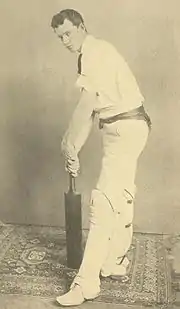
In 1881, Penn, Harvard College, Haverford College, Princeton College (then known as College of New Jersey), and Columbia College formed The Intercollegiate Cricket Association,[375] which Cornell University later joined.[367] Penn won The Intercollegiate Cricket Association championship (the de facto national championship) 23 times (18 solo, 3 shared with Haverford and Harvard, 1 shared with Haverford and Cornell, and 1 shared with just Haverford) during the 44 years that The Intercollegiate Cricket Association existed (1881 through 1924).[377]
In the 1890s Penn's cricket team frequently toured Canada and the British Isles.[378] In July 1895 an international cricket match between Canada and the United States was played on the Manheim grounds in Germantown section of Philadelphia with six of the United States team being Penn student athletes and, in September of that year, past and then current members of Penn's varsity cricket team played past and then current members of the English cricket teams of Oxford and Cambridge resulting in Penn defeating the Oxford-Cambridge team by one hundred runs.[367] This was not surprising as in the last two and a half decades of the 19th century and first decade of the 20th century, Philadelphia was the center of cricket in the United States[379]
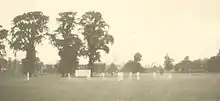
Cricket had gained in popularity among the upper class from their travels abroad and cricket clubs sprung up all across the Eastern Seaboard (even today Philadelphia still has three cricket clubs: the Philadelphia Cricket Club, the Merion Cricket Club and the Germantown Cricket Club).
Perhaps the university's most famous cricket player was George Patterson (class of 1888), who still holds the North American batting record and who went on to play for the professional Philadelphia Cricket Team.[380]
Following the First World War, cricket began to experience a serious decline (as baseball became the preferred sport of the warmer months and Imperial Cricket Conference, Cricket's "... international governing body and forerunner to the current International Cricket Conference (ICC), introduced a regulation making it clear that only countries within the British empire were welcome to compete")[374] such that in 1924 Penn fielded its last team in the twentieth century. Starting in 2009, however, Penn once again fielded a cricket team, albeit club, that ended up being the first winner of a tournament for teams from the Ivies.[381]
Rowing
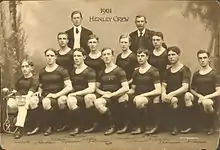
_LCCN2014647516.jpg.webp)
Rowing (crew) at Penn dates back to at least 1854 with the founding of the University Barge Club. The university currently hosts both heavyweight and lightweight men's teams and an open weight women's team, all of which compete as part of the Eastern Sprints League. Ellis Ward was Penn's first intercollegiate crew coach from 1879 through 1912.[383] During the course of Ward's coaching career at Penn his "... Red and Blue crews won 65 races, in about 150 starts."[384] Importantly, Ward coached Penn's 8-oared boat to the finals of the Grand Challenge Cup (the oldest and most prized trophy) at the Henley Royal Regatta (but in that final race was defeated by the champion Leander Club).[385]
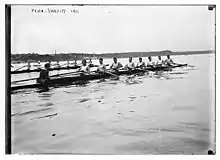
Penn Rowing has produced a long list of famous coaches and Olympians. Members of Penn crew team, rowers Sidney Jellinek, Eddie Mitchell, and coxswain, John G. Kennedy, won the bronze medal for the United States at 1924 Olympics.[386]
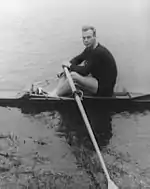
Joe Burk (class of 1935) was captain of Penn crew team, winner of the Henley Diamond Sculls twice, named recipient of the James E. Sullivan Award for nation's best amateur athlete in 1939, and Penn coach from 1950 to 1969. The 1955 Men's Heavyweight 8, coached by Joe Burk, became one of only four American university crews in history to win the Grand Challenge Cup at the Henley Royal Regatta. The outbreak of World War Two canceled the 1940 Olympics for which Burk was favored to win the gold medal.
Other Penn Olympic athletes and or Penn coaches of such athletes include: (a) John Anthony Pescatore (who competed in the 1988 Seoul Olympic Games for the United States as stroke of the men's coxed eight which earned a bronze medal[388] and later competed at the 1992 Barcelona Olympic Games in the men's coxless pair), (b) Susan Francia (winner of gold medals as part of the women's 8 oared boat at 2008 Olympics and 2012 Olympics), (c) Regina Salmons (member of 2021 USA team),[389] (d) Rusty Callow, (e) Harry Parker, (f) Ted Nash,[386] and (g) John B. Kelly Jr., son of John B. Kelly Sr. (winner of three medals at 1920 Summer Olympics) and brother of Princess Grace of Monaco, was the 2nd Penn Crew Alumnus to win the James E. Sullivan Award[390] for being nation's best amateur athlete (in 1947), who was winner of a bronze medal at the 1956 Summer Olympics).
The Penn men's crew team won the National Collegiate Rowing Championship in 1991. A member of that team, Janusz Hooker (Wharton class of 1992)[391] won the bronze medal in Men's Quadruple Sculls for Australia at the 1996 Summer Olympics.[392] The Penn teams presently row out of College Boat Club, No.11 Boathouse Row.
Rugby
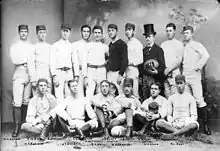
The Penn men's rugby football team is one of the oldest collegiate rugby teams in the United States. Indeed, Penn first fielded a team in mid 1870s playing by rules much closer to the rugby union and Association Football code rules (relative to American football rules, as such American football rules had not yet been invented[368]). Among its earliest games was a game against College of New Jersey (which in 1895 changed its name to Princeton) played in Philadelphia on Saturday, November 11, 1876, which was less than two weeks before Princeton met on November 23, 1876, with Harvard and Columbia to confirm that all their games would be played using the rugby union rules.[394][368] Princeton and Penn played their November 1876 game per a combination of rugby (there were 20 players per side and players were able to touch the ball with their hands) and Association Football codes. The rugby code influence was due, in part, to the fact that some of their students had been educated in English public schools.[395]
Among the prominent alumni to play in a 19th-century version of rugby (rules that did not allow forward passes or center snaps) was John Heisman, namesake of the Heisman Trophy and an 1892 graduate of the University of Pennsylvania Law School.[396]
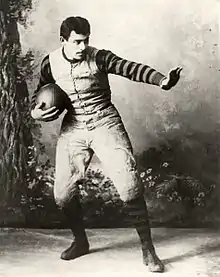
Heisman was instrumental in the first decade of the 20th century in changing the rules to more closely relate to the present rules of American football.[398] One of Heisman's teammates (who was unanimously voted Captain in the fall after Heisman graduated) was Harry Arista Mackey, Penn Law class of 1893[399] (who subsequently served as Mayor of Philadelphia from 1928 to 1932).[400]
In 1906, Rugby per Rugby Union code was reintroduced to Penn[401] (as Penn last played per Rugby Union Code in 1882 as Penn played rugby per a number of different rugby football rulebooks and codes from 1883 through 1890s[402]) by Frank Villeneuve Nicholson (Frank Nicholson (rugby union)) University of Pennsylvania School of Dental Medicine (class of 1910),[403] who in 1904 had captained the Australian national rugby team in its match against England.[404]
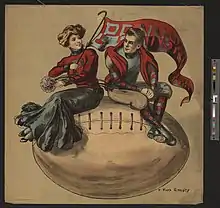
Penn played per rugby union code rules at least through 1912, contemporaneously with Penn playing American gridiron football. Evidence of such may be found in an October 22, 1910, Daily Pennsylvanian article (quoted below) and a yearbook photo[405] that rugby per rugby union code was played.
Such is the devotion to English rugby football on the part of University of Pennsylvania's students from New Zealand, Australia, and England that they meet on Franklin Field at 7 o'clock every morning and practice the game. The varsity track and football squads monopolize the field to such an extent that the early hours of the morning are the only ones during which the rugby enthusiasts can play. Any time except Friday, Saturday and Sunday, a squad of 25 men may be seen running through the hardest kind of practice after which they may divide into two teams and play a hard game. Once a week, captain CC Walton, ('11), dental, who hails from New Zealand, gives the enthusiastic players a blackboard talk in which he explains the intricacies of the game in detail.[406]
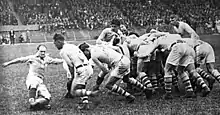
The player-coach of United States Olympic gold-winning rugby team at the 1924 Summer Olympics was Alan Valentine, who played rugby while at Penn (which he attended during 1921/1922 academic year) as he was getting a master's degree at Wharton.[408]
Though Penn played rugby per rugby union rules from 1929 through 1934,[409] there is no indication that Penn had a rugby team from 1935 through 1959 when Penn men's rugby became permanent due to leadership of Harry "Joe" Edwin Reagan III[410] Penn's College class of 1962 and Penn Law class of 1965, who also went onto help create and incorporate (in 1975) and was Treasurer (in 1981) of USA Rugby and Oreste P. "Rusty" D'Arconte Penn's College class of 1966[411] Thus, with D'Arconte's hustle and Reagan's charisma and organizational skills, a team, which had fielded a side of fifteen intermittently from 1912 through 1960, became permanent.
In spring of 1984[412][413] Penn women's rugby, led by Social Chair Tamara Wayland (College class of 1985 who subsequently became the women's representative to and vice president of USA Rugby South from 1996 to 1998),[414] Club President Marianne Seligson, and Penn Law student Gigi Sohn,[415] began to compete. Penn women's rugby team is coached, as of 2020, by (a) Adam Dick,[416] a 300-level certified coach with over 15 years of rugby coaching experience including being the first coach of the first women's rugby team at the University of Arizona and who was a four-year starter at University of Arizona men's first XV rugby team and (b) Philly women's player Kate Hallinan.
Penn's men's rugby team plays in the Ivy Rugby Conference[417] and have finished as runners-up in both 15s and 7s in the Conference and won the Ivy Rugby Tournament in 1992.[418] As of 2011, the club uses the state-of-the-art facilities at Penn Park. The Penn Quakers' rugby team played on national TV at the 2013 Collegiate Rugby Championship, a college rugby tournament that for number of years had been played each June at PPL Park (now known as Subaru Park) in Philadelphia and was broadcast live on NBC. In their inaugural year of participation, the Penn men's rugby team won the Shield Competition, beating local Big Five rival, Temple University, 17–12 in the final. In the semifinal match of that Shield Competition, Penn Rugby became the first Philadelphia team to beat a non-Philadelphia team in CRC history, with a 14–12 win over the University of Texas.[419]
Penn men's rugby, as of 2020,[420] is coached by Tiger Bax,[421] a former professional rugby player hailing from Cape Town, South Africa, whose playing experience includes stints in the Super Rugby competition with the Stormers (15s) and Mighty Mohicans (7s), as well as with the Gallagher Premiership Rugby side, Saracens[422] and whose coaching experience includes three successful years as coach at Valley Rugby Football Club in Hong Kong; and Tyler May, from Cherry Hill, New Jersey, who played rugby at Pennsylvania State University where he was a first XV player for three years.
Players on the 2019 men's team came from 11 countries: Australia, Botswana, Chile, Great Britain, Malaysia, Netherlands, New Zealand, China, Taiwan, South Africa, and the United States).
Penn's graduate and professional schools also fielded rugby teams. The Penn Law Rugby team (1985 through 1993) counts among its alumni Walter Joseph Jay Clayton, III[423] Penn Law class of 1993, and chair of the U.S. Securities and Exchange Commission from May 4, 2017, until December 23, 2020, and Raymond Hulser, former Chief of Public Integrity Section of United States Department of Justice.[424] The Wharton rugby team has competed from 1978 to the present.[425] Other recent Penn Rugby Alumni include Conor Lamb (Penn College class of 2006 and Penn Law class of 2009), who played for undergraduate team (and had an additional year of eligibility allowing him to continue to playing for undergraduate team while a student at Penn Law per USA Rugby rules), and, as of 2021, is a member of United States House of Representatives, elected originally to Pennsylvania's 18th congressional district, since 2019 is a U.S. Representative from Pennsylvania's 17th congressional district.
Football

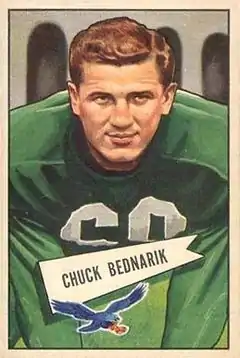
Penn first fielded a football team against Princeton at the Germantown Cricket Club in Philadelphia on November 11, 1876.[394]
Penn football made many contributions to the sport in its early days. During the 1890s, Penn's famed coach and alumnus George Washington Woodruff introduced the quarterback kick, a forerunner of the forward pass, as well as the place-kick from scrimmage and the delayed pass. In 1894, 1895, 1897 and 1904, Penn was generally regarded as the national champion of collegiate football.[394] Among the key players on the teams from 1897 to 1900 was Truxton Hare, Sr. who was selected as a charter member of the College Football Hall of Fame in 1951. While primarily a guard, he also ran, punted, kicked off, and drop-kicked extra points.
The achievements of two of Penn's other outstanding players from that era, John Heisman, a Law School alumnus, and John Outland, a Penn Med alumnus, are remembered each year with the presentation of the Heisman Trophy to the most outstanding college football player of the year, and the Outland Trophy to the most outstanding college football interior lineman of the year.
Also, each year the Bednarik Award is given to college football's best defensive player. Chuck Bednarik (class of 1949) was a three-time All-American center/linebacker who starred on the 1947 team and is generally regarded as Penn's all-time finest. In addition to Bednarik, the 1947 squad boasted four-time All-American tackle George Savitsky and three-time All-American halfback Skip Minisi. All three standouts were subsequently elected to the College Football Hall of Fame, as was their coach, George Munger (a star running back at Penn in the early 1930s). Bednarik went on to play for 12 years with the Philadelphia Eagles, and was elected to the Pro Football Hall of Fame in 1969.
Penn's game against University of California at Berkeley on September 29, 1951 (in front of a crowd of 60,000 at Franklin Field), was first college football game to be broadcast in color.[426][427] ESPN's College GameDay traveled to Penn to highlight the Harvard–Penn game on November 17, 2002, the first time the popular college football show had visited an Ivy League campus.
Basketball


Penn basketball is steeped in tradition. Penn made its only (and the Ivy League's second) Final Four appearance in 1979, where the Quakers lost to Magic Johnson-led Michigan State in Salt Lake City. (Dartmouth twice finished second in the tournament in the 1940s, but that was before the beginning of formal League play.) Penn's team is also a member of the Philadelphia Big 5, along with La Salle, Saint Joseph's, Temple and Villanova. In 2007, the men's team won its third consecutive Ivy League title and then lost in the first round of the NCAA Tournament to Texas A&M. Penn last made the NCAA tournament in 2018 where it lost to top seeded Kansas.[428]
Olympic athletes
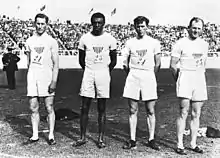
%252C_1907_ICAA_point_winners_UPenn.jpg.webp)
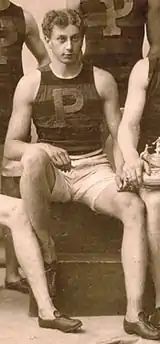
At least 43 different Penn alumni have earned 81 Olympic medals (26 gold).[432][433] Penn won more of its "medals"[432] (which were actually cups, trophies, or plaques, as medals were not introduced until a later Olympics) at 1900 Summer Olympics held in Paris than any other Olympics.[434] Penn's track and field alumni who won 21 'medals' at the 1900 Paris Olympics are: (1) Alvin Kraenzlein (University of Pennsylvania School of Dental Medicine class of 1900),[431] known as "the father of the modern hurdling technique",[435] who was first sportsman in the history of Olympic games to win four individual gold medals in a single discipline;[436][437] (2) Josiah McCracken, MD (University of Pennsylvania School of Medicine class of 1901) who won the silver medal in the shot put and a bronze medal for the hammer throw;[438][439][440] (3) John Walter Tewksbury (Penn Dental School class of 1899) who won five 'medals' (gold in the 200 meter dash and 400 meter hurdles, silver in the 60 meter dash and 100 meter dash, and a bronze in the 200 meter hurdles);[441] (4) Irving Baxter (Penn Law class of 1901) who won five "medals" (gold in both the men's high jump and men's pole vault and silver in all three of the standing jumps (long, triple, and high);[442][443] (5) Meredith Colket (College Class of 1901 (BS), Penn Law class of 1904) who won the silver 'medal' in the pole vault,[444] (6) Truxton Hare (Penn Law class of 1904) who won the silver 'medal' in the hammer throw[445] (and at 1904 Summer Olympics held in St. Louis, Missouri, won (i) bronze medal in the all-around discipline (which consisted of 100 yard run, shot put, high jump, 880 yard walk, hammer throw, pole vault, 120 yard hurdles, long jump and one mile run), and (ii) gold medal as part of United States tug of war team),[445] and (7) George Orton (University of Pennsylvania Graduate School of Arts and Sciences class of 1894 (MA) and class of 1896 (PhD)) who (as first physically disabled Olympic athlete) won a gold 'medal' in the 2,500 meter run and a bronze metal in the 400 meter hurdles[446]
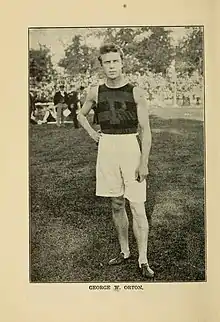
The first African American in the United States to win an Olympic gold medal at an Olympics, the 1908 London Olympics, as part of Medley relay where he ran the third leg, the 400 meters, was John Taylor (University of Pennsylvania School of Veterinary Medicine (class of 1908)). Taylor was followed by William Hamilton and Nate Cartmell (fellow Penn athlete).[429]
In the 2020 Summer Olympics held in Tokyo, Japan, in summer of 2021, nine Penn students and alumni played in six different sports from six different countries.[447]
Facilities
Franklin Field (with seats for 52,593 fans[448]) is where the Quakers play football, field hockey, lacrosse, sprint football and track and field (and formerly baseball, soccer, and rugby). It is the oldest stadium still operating for football games, the first stadium to sport two tiers, and first stadium in the country to have a scoreboard. It hosted the first ever football radio broadcast (in 1922) and first commercially televised football game (in 1940) and was site of first ever use of use of instant replay (in 1963).[449] Franklin Field also played host to the Philadelphia Eagles from 1958 to 1970 (where installation of artificial turf in 1969 caused it to be first NFL stadium to have such artificial turf),[450] and was the site of 18 Army–Navy games between 1899 and 1935.[451]
Today it is also used by Penn students for recreation such as intramural and club sports, including touch football and cricket. Franklin Field hosts the annual collegiate track and field event "the Penn Relays."
Penn's home court, the Palestra, is an arena used for men's and women's basketball teams, volleyball teams, wrestling team, and Philadelphia Big Five basketball, as well as high school sporting events. The Palestra has hosted more NCAA Tournament basketball games than any other facility. Penn staff and students make use of the Palestra to play and/or watch basketball, volleyball, and fencing. Penn's River Fields hosts a number of athletic fields including the Rhodes Soccer Stadium (for both women's and men's soccer, which includes elevated stands for 650 spectators, a 180-degree rotating scoreboard, and the Rapaport Family Suite), the Ellen Vagelos C'90 Field Hockey Field (with special artificial turf), and Irving "Moon" Mondschein Throwing Complex (for javelin, shot put, discus, and Hammer throw).[452] In addition, Penn baseball plays its home games at Meiklejohn Stadium at Murphy Field.
The Olympic Boycott Games of 1980 was held at the University of Pennsylvania in response to Moscow's hosting of the 1980 Summer Olympics following the Soviet incursion in Afghanistan. Twenty-nine of the boycotting nations participated in the Boycott Games.
Notable people
Gallery
 Francis Hopkinson, signed the Declaration of Independence and designed the first official American flag.
Francis Hopkinson, signed the Declaration of Independence and designed the first official American flag.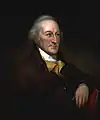 George Clymer, Founding Father; early advocate for complete independence from Britain
George Clymer, Founding Father; early advocate for complete independence from Britain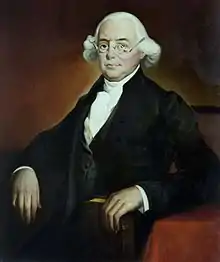 James Wilson, Founding Father; one of the six original justices appointed by George Washington to the Supreme Court of the United States
James Wilson, Founding Father; one of the six original justices appointed by George Washington to the Supreme Court of the United States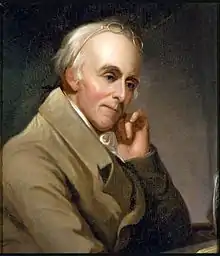 Benjamin Rush, Founding Father; surgeon general of the Continental Army
Benjamin Rush, Founding Father; surgeon general of the Continental Army William Henry Harrison, 9th president of the United States
William Henry Harrison, 9th president of the United States Donald Trump, 45th president of the United States
Donald Trump, 45th president of the United States Martha Hughes Cannon, first female state senator elected in the United States
Martha Hughes Cannon, first female state senator elected in the United States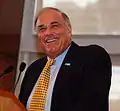 Ed Rendell, 45th governor of Pennsylvania; 96th mayor of Philadelphia
Ed Rendell, 45th governor of Pennsylvania; 96th mayor of Philadelphia Jon Huntsman Jr., politician, businessman, and diplomat
Jon Huntsman Jr., politician, businessman, and diplomat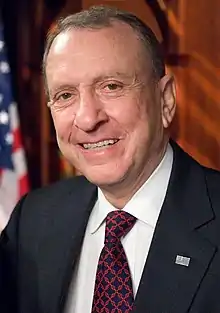 Arlen Specter, former U.S. senator, majored in international relations and graduated Phi Beta Kappa in 1951.
Arlen Specter, former U.S. senator, majored in international relations and graduated Phi Beta Kappa in 1951. William Brennan Jr., Associate Justice of the United States Supreme Court
William Brennan Jr., Associate Justice of the United States Supreme Court.jpg.webp) Kwame Nkrumah, first president of Ghana, and previously first prime minister of Ghana
Kwame Nkrumah, first president of Ghana, and previously first prime minister of Ghana.jpg.webp) Alassane Ouattara, President of Cote de Ivoire since 2010
Alassane Ouattara, President of Cote de Ivoire since 2010.jpg.webp) Drew Gilpin Faust, 28th president of Harvard University
Drew Gilpin Faust, 28th president of Harvard University Doc Holliday, famed gunslinger, attended the Pennsylvania College of Dental Surgery.
Doc Holliday, famed gunslinger, attended the Pennsylvania College of Dental Surgery.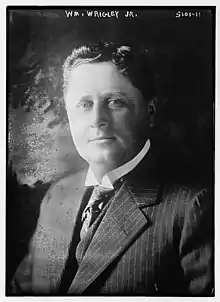 William Wrigley, Jr., founder and eponym of the Wm. Wrigley Jr. Company
William Wrigley, Jr., founder and eponym of the Wm. Wrigley Jr. Company Physician and poet William Carlos Williams graduated from Penn's School of Medicine
Physician and poet William Carlos Williams graduated from Penn's School of Medicine Ezra Pound, poet and critic; a major figure in the early modernist poetry movement
Ezra Pound, poet and critic; a major figure in the early modernist poetry movement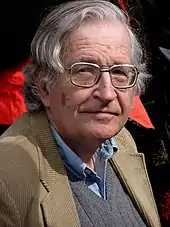 Noam Chomsky studied philosophy and linguistics at Penn, graduating with a BA in 1949, an MA in 1951 and a PhD in 1955.
Noam Chomsky studied philosophy and linguistics at Penn, graduating with a BA in 1949, an MA in 1951 and a PhD in 1955.
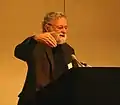 Donald Arthur Norman, co-founder of the Nielsen Norman Group,[455] an IDEO fellow, and researcher and advocate of user-centered design
Donald Arthur Norman, co-founder of the Nielsen Norman Group,[455] an IDEO fellow, and researcher and advocate of user-centered design
 Tory Burch, fashion designer and founder of Tory Burch LLC
Tory Burch, fashion designer and founder of Tory Burch LLC John Legend, musician and recipient of Academy, Emmy, Grammy, and Tony Awards
John Legend, musician and recipient of Academy, Emmy, Grammy, and Tony Awards Stanley B. Prusiner, neurologist and biochemist, recipient of the Nobel Prize in Physiology or Medicine
Stanley B. Prusiner, neurologist and biochemist, recipient of the Nobel Prize in Physiology or Medicine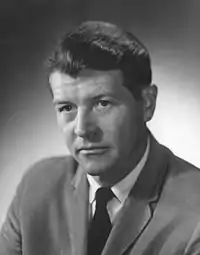 Christian B. Anfinsen, biochemist, recipient of the Nobel Prize in Chemistry
Christian B. Anfinsen, biochemist, recipient of the Nobel Prize in Chemistry I. M. Pei, Pritzker Prize-winning architect
I. M. Pei, Pritzker Prize-winning architect
Overview
Penn has produced many alumni that have distinguished themselves in the sciences, academia, politics, business, military, arts, and media.[459]
Some eleven heads of state or government have attended or graduated from Penn, including former president Donald Trump;[459] former president William Henry Harrison, who attended the medical school for less than a semester;[460] former prime minister of the Philippines Cesar Virata; the first president of Nigeria, Nnamdi Azikiwe; the first president of Ghana, Kwame Nkrumah; and the current president of Ivory Coast, Alassane Ouattara. Other notable politicians who hold a degree from Penn include India's former minister of state for finance Jayant Sinha,[461] former ambassador and Utah governor Jon Huntsman, Jr., Mexico's current minister of finance, Ernesto J. Cordero, former Pennsylvania senator Arlen Specter, and former Pennsylvania governor and DNC chair Ed Rendell.[462]
The university's presence in the judiciary in and outside of the United States is also notable. It has produced three United States Supreme Court justices, William J. Brennan, Owen J. Roberts and James Wilson; Supreme Court justices of foreign states (e.g., Ronald Wilson of the High Court of Australia, Ayala Procaccia of the Israel Supreme Court, Yvonne Mokgoro, former justice of the Constitutional Court of South Africa); and Irish Court of Appeal justice Gerard Hogan.
Penn is also a top feeder school for careers in finance and investment banking on Wall Street[463] and its alumni have a strong presence in financial and economic life. Indeed, Penn alumni include 64 living billionaires, 28 of whom are undergraduate alumni billionaires (as Penn has the second highest number of undergrad billionaire alumni with only Harvard [with only one more (but Penn undergraduate alumni billionaires have accumulated over 65 billion more in wealth than Harvard's)],[464][465] Penn has educated several governors of central banks including Dawne Williams ( St. Kitts-Nevis-Anguilla National Bank), Yasin Anwar (State Bank of Pakistan), Ignazio Visco (Bank of Italy), Kim Choongsoo (Bank of Korea), Zeti Akhtar Aziz (Central Bank of Malaysia), Pridiyathorn Devakula (governor, Bank of Thailand, and former minister of finance), Farouk El Okdah (Central Bank of Egypt) and Alfonso Prat Gay (Central Bank of Argentina), as well as the director of the United States National Economic Council, Gene Sperling.[466] Other alumni include Warren Buffett [note 6] (CEO of Berkshire Hathaway),[459] Steven A. Cohen (founder of SAC Capital Advisors), and Robert Kapito (president of BlackRock, the world's largest asset manager).[467]
Penn alumni who are founders of technology companies include Ralph J. Roberts (co-founder of Comcast); Elon Musk (co-founder of PayPal, Tesla, OpenAI and Neuralink, founder of SpaceX and The Boring Company); Leonard Bosack (co-founder of Cisco); David J. Brown (co-founder of Silicon Graphics) and Mark Pincus (founder of Zynga, the company behind FarmVille).
Among other distinguished alumni are the current or past presidents of over one hundred universities including Harvard University (Drew Gilpin Faust, Harvard's first female president), Cornell University (Martha E. Pollack), Penn (Judith Rodin, first female president in the Ivy League), Princeton University (Harold Dodds), the University of California (Mark Yudof), Carnegie Mellon University (Jared Cohon), and Northwestern University (Morton O. Schapiro).
Penn's alumni also include poets William Augustus Muhlenberg, Ezra Pound and William Carlos Williams; linguist and political theorist Noam Chomsky;[459] architect Louis Kahn; cartoonist Charles Addams; actresses Candice Bergen and Elizabeth Banks; journalist Joe Klein; fashion designer Tory Burch, and alumni who have won 20 Tony Awards, 16 Grammy Awards, 11 Emmy Awards, and 4 Academy Awards (Oscars)[468] as exemplified by EGOT recipient, recording artist John Legend.[469]
Within the ranks of Penn's most historic graduates are also eight signers of the Declaration of Independence[470][471] and seven signers of the United States Constitution[472] and 24 members of the Continental Congress. These historic figures include George Clymer, Francis Hopkinson, Thomas McKean, Robert Morris, William Paca, George Ross, Benjamin Rush, James Wilson, Thomas Fitzsimons, Jared Ingersoll, Rufus King, Thomas Mifflin, Gouverneur Morris and Hugh Williamson.
Penn alumni have also had significant impact on the United States military as they include Samuel Nicholas, United States Marine Corps founder, and William A. Newell, whose congressional action formed a predecessor to the current United States Coast Guard,[473]: p.1 col.5 – p.2 col.1 in addition to numerous generals or similar rank in the United States Armed Forces, as well as at least five United States Medal of Honor recipients.[16][17]
As of 2020, there have been 24 Nobel Laureates affiliated (see List of Nobel laureates by university affiliation), with the University of Pennsylvania,[474][459] of whom four are current faculty members and eight are alumni. Penn also educated members of the United States National Academies and the Academy of Arts and Sciences, eight National Medal of Science laureates, numerous Sloan Fellows, several members of the American Philosophical Society and many Guggenheim Fellowships.
Alumni relations and inter-Ivy events
In addition to active alumni chapters globally, in 1989, the university bought a 14-story clubhouse building (purpose built for Yale Club) in New York City from Touro College for $15 million[475] to house Penn's largest alumni chapter. After raising a separate $25 million (including $150,000+ donations each from Estee Lauder heirs, Leonard Lauder and Ronald Lauder, Saul Steinberg, Michael Milken, and Ronald Perelman) and two years of renovation,[476] the Penn Club of New York moved to said current location on NYC's Clubhouse Row[477] directly in front of the Harvard Club of New York, on the same block as the Cornell Club of New York, and a block away from the Yale Club of New York City and Princeton Club of New York for inter-Ivy events. Despite the university being in New York City, the Columbia University Club of New York shares a clubhouse with the Penn Club. The New York region of the university maintains an office in the Penn Club.
See also
- List of universities by number of billionaire alumni
- Education in Philadelphia
- Think Tanks and Civil Societies Program (TTCSP)
- University of Pennsylvania Press
Notes
- The university officially uses 1740 as its founding date and has since 1899. The ideas and intellectual inspiration for the academic institution stem from 1749, with a pamphlet published by Benjamin Franklin (1705/1706–1790). When Franklin's institution was established, it inhabited a schoolhouse built on November 14, 1740, for another school, which never came to practical fruition.[3] Penn archivist Mark Frazier Lloyd noted, "In 1899, UPenn's Trustees adopted a resolution that established 1740 as the founding date, but good cases may be made for 1749, when Franklin first convened the Trustees, or 1751, when the first classes were taught at the affiliated secondary school for boys, Academy of Philadelphia, or 1755, when Penn obtained its collegiate charter to add a post-secondary institution, the College of Philadelphia."[4] Princeton's library presents another diplomatically-phrased view.[5]
- Penn is the fourth-oldest using the founding dates claimed by each institution. The College of Philadelphia (later Penn), College of New Jersey (later Princeton University) and King's College (later Columbia College, now Columbia University) all originated within a few years of each other. After initially designating 1750 as its founding date, Penn later considered 1749 to be its founding date for more than a century, including alumni observing a centennial celebration in 1849. In 1895, several elite universities in the United States convened in New York City as the "Intercollegiate Commission" at the invitation of John J. McCook, a Union Army officer during the American Civil War and member of Princeton's board of trustees who chaired its Committee on Academic Dress. The primary purpose of the conference was to standardize American academic regalia, which was accomplished through the adoption of the Intercollegiate Code on Academic Costume. This formalized protocol included a provision that henceforth academic processions would place visiting dignitaries and other officials in the order of their institution's founding dates. The following year, Penn's The Alumni Register magazine, published by the General Alumni Society, began a campaign to retroactively revise the University's founding date to 1740, to become older than Princeton, which had been chartered in 1746. Three years later in 1899, Penn's board of trustees acceded to this alumni initiative and officially changed its founding date from 1749 to 1740, affecting its rank in academic processions as well as the informal bragging rights that come with the age-based hierarchy in academia generally. See "Building Penn's Brand" for more details on why Penn did this.[18] Princeton implicitly challenges this rationale,[19] also considering itself to be the nation's fourth-oldest institution of higher learning.[20] To further complicate the comparison, a University of Edinburgh-educated Presbyterian minister from Scotland, named William Tennent and his son Gilbert Tennent operated a "Log College" in Bucks County, Pennsylvania, from 1726 until 1746; some have suggested a connection between it and Princeton because five members of Princeton's first Board of Trustees were affiliated with the "Log College", including Gilbert Tennent, William Tennent, Jr., and Samuel Finley, the latter of whom later became President of Princeton. All twelve members of Princeton's first Board of Trustees were leaders from the "New Side" or "New Light" wing of the Presbyterian Church in the New Jersey, New York and Pennsylvania areas.[21] This antecedent relationship, when considered a formal lineage with institutional continuity, would justify pushing Princeton's founding date back to 1726, earlier than Penn's 1740. However, Princeton has not done so, and a Princeton historian says that "the facts do not warrant" such an interpretation.[22] Columbia also implicitly challenges Penn's use of either 1750, 1749 or 1740, as it claims to be the fifth oldest institution of higher learning in the United States (after Harvard, William & Mary, Yale and Princeton), based upon its charter date of 1754 and Penn's charter date of 1755.[23] Academic histories of American higher education generally list Penn as fifth or sixth, after Princeton and immediately before or after that of Columbia.[24][25][26] Even Penn's account of its early history agrees that the original secondary school (the Academy of Philadelphia) did not add an institution of higher learning (the College of Philadelphia) until 1755, but university officials continue to make it their practice to assert their fourth-oldest place in academic processions. Other American universities that began as a colonial-era, early version of secondary schools such as St. John's College (founded as "King William's School" in 1696) and the University of Delaware (founded as "the Free Academy" in 1743) choose to march based upon the date they became institutions of higher learning. Penn History Professor Edgar Potts Cheyney was a member of the Penn class of 1883 who played a leading role in the 1896-1899 alumni campaign to change the university's formal founding date. According to Cheyney's later history of the event, the university did indeed consider its founding date to be 1749 for almost a century. However, it was changed with good reason, and primarily due to a publication about the university issued by the U.S. Commissioner of Education written by Francis Newton Thorpe, a fellow alumnus, and colleague in the Penn history department. The year 1740 is the date of the establishment of the first educational trust that the University had taken upon itself. Cheyney states further that "it might be considered a lawyer's date; it is a familiar legal practice in considering the date of any institution to seek out the oldest trust it administers". He also points out that Harvard's founding date is also the year in which the Massachusetts General Court (state legislature) resolved to establish a fund in a year's time for a "School or College". As well, Princeton claims its founding date as 1746, the date of its first charter. However, the exact words of the charter are unknown, the number and names of the trustees in the charter are unknown, and no known original is extant. Except for Columbia University, the majority of the American Colonial Colleges do not have clear-cut dates of foundation.[27]
- In 1790, the first lecture on law was given by James Wilson; however, a full time program was not offered until 1850.[156]
- Note other sources states Class of 1930[284]
- the cricket "ground" was on land owned by the Union Club of Camden, New Jersey, which, in 1840, arguably organized the first cricket team in the United States) and site was formerly occupied by Camden and Amboy Rail Road and Transportation Company[371]
- Buffett studied at Penn for two years before he transferred to the University of Nebraska.
References
- "Penn in the 18th Century". upenn.edu. Archived from the original on April 28, 2006. Retrieved July 20, 2021.
- Note: It was not until 1785 that the name was made official as between 1779 and 1785 name was simply "University" in Philadelphia see "Statutes of the Trustees". University of Pennsylvania. Retrieved September 12, 2022.
- "Penn History Exhibits". University Archives and Records Center. Archived from the original on August 22, 2019. Retrieved January 31, 2019.
- "A Penn Trivial Pursuit – Penn Current". June 3, 2011. Archived from the original on June 3, 2011.
- "Seeley G. Mudd Library: FAQ Princeton vs. University of Pennsylvania: Which is the Older Institution?". March 19, 2003. Archived from the original on March 19, 2003.
- As of June 30, 2022. About Us Penn Office of Investments (Report). Penn Office of Investments. June 30, 2022. Retrieved September 24, 2022.
- "Operating Budget". Office of Budget and Management Analysis. University of Pennsylvania. Archived from the original on November 12, 2019. Retrieved January 19, 2020.
- Snyder, Susan (February 4, 2022). "With Amy Gutmann's departure expected soon, Penn names interim president". The Inquirer. Retrieved February 11, 2022.
- Ahn, Ashley. "Scott Bok, investment banker and Penn grad, to serve as next chair of Board of Trustees". The Daily Pennsylvanian. Retrieved September 24, 2021.
{{cite news}}: CS1 maint: url-status (link) - "Penn: Penn Facts". University of Pennsylvania. Archived from the original on October 23, 2019. Retrieved January 18, 2020.
- "Facts | University of Pennsylvania". www.upenn.edu.
- "Common Data Set 2019–20" (PDF). University of Pennsylvania. Archived from the original (PDF) on May 23, 2020. Retrieved March 23, 2020.
- "Logo & Branding Standards". University of Pennsylvania. Archived from the original on July 23, 2019. Retrieved April 1, 2016.
- (The registered trademark as the primary substitute for using the University's full name and part of official brand), accessed June 9, 2021
- (permissible in situations where it may help to distinguish Penn from other universities within the Commonwealth of Pennsylvania and used as part of email address), accessed June 9, 2021
- Ahern, Joseph-James; Hawley, Scott W. (January 2011). "Congressional Medals of Honor, Recipients from the Civil War • University Archives and Records Center". Penn University Archives and Records Center.
- "Frederick C. Murphy, Our Facility's Namesake". archives.gov. National Archives at Boston. August 15, 2016. Retrieved June 24, 2018.
- "Gazette: Building Penn's Brand (Sept/Oct 2002)". www.upenn.edu. Archived from the original on November 20, 2005. Retrieved January 25, 2006.
- "History". Princeton University. Archived from the original on August 5, 2019. Retrieved May 16, 2019.
- "Princeton University in the American Revolution". Princeton University. Archived from the original on April 3, 2016.
- "Who founded Princeton University and when?". Princeton University. Archived from the original on November 5, 2013.
- "Log College". Princeton University. Archived from the original on November 17, 2005. Retrieved January 30, 2006.
- "History – Columbia University in the City of New York". www.columbia.edu. Archived from the original on May 17, 2019. Retrieved May 16, 2019.
- "COH-03-057_Page-45". dmr.bsu.edu. Archived from the original on January 22, 2020. Retrieved May 16, 2019.
- "American Colonial Colleges" (PDF). scholarship.rice.edu. Archived (PDF) from the original on January 16, 2013. Retrieved May 16, 2019.
- Zubatsky, David (2007). "The History of American Colleges and Their Libraries in The Seventeenth and Eighteenth Centuries" (PDF). ideals.illinois.edu. Archived (PDF) from the original on October 28, 2014. Retrieved May 16, 2019.
- Edgar Potts Cheyney, "History of the University of Pennsylvania: 1740–1940", Philadelphia: University of Pennsylvania Press, 1940: pp. 45–52.
- Montgomery, Thomas Harrison (1900). A History of the University of Pennsylvania from Its Foundation to A. D. 1770. Philadelphia: George W. Jacobs & Co. LCCN 00003240.
- "Richard Peters". Archives.upenn.edu. January 24, 2022. Retrieved May 31, 2022.
- Friedman, Steven Morgan. "A Brief History of the University, University of Pennsylvania Archives". Archives.upenn.edu. Archived from the original on January 2, 2010. Retrieved December 9, 2010.
- Strawbridge, Justus C. (1899). Ceremonies Attending the Unveiling of the Statue of Benjamin Franklin. Allen, Lane & Scott. ISBN 978-1-103-92435-6. Retrieved November 24, 2007.
justus c strawbridge.
- "Penn's Heritage". University of Pennsylvania. Archived from the original on April 22, 2016. Retrieved May 8, 2016.
- N. Landsman, From Colonials to Provincials: American Thought and Culture, 1680–1760 (Ithaca: Cornell University Press, 1997), p. 30.
- Reproduction of a sketch by French artist Pierre Eugène Du Simitière courtesy of Wikipedia Commons
- Wood, George Bacon (1834). The History of the University of Pennsylvania, from Its Origin to the Year 1827. McCarty and Davis. LCCN 07007833. OCLC 760190902.
- "Penn in the 18th Century, University of Pennsylvania Archives". University of Pennsylvania. Archived from the original on April 28, 2006. Retrieved April 29, 2006.
- Note "...(d) On November 27, 1779, the General Assembly of the Commonwealth of Pennsylvania passed an act for the establishment of a University incorporating the rights and powers of the College, Academy, and Charitable School. This was the first designation of an institution in the United States as a University; (e) On September 22, 1785, an act was passed naming the University the University of the State of Pennsylvania..." See "Statues of the Trustees". University of Pennsylvania. Retrieved September 12, 2022.
- "Penn Trustees 1749-1800". University of Pennsylvania University Archives. Archived from the original on November 25, 2012. Retrieved July 23, 2013.
- Cheyney, Edward Potts (1940). "History of the University of Pennsylvania 1740–1940". History of the University of Pennsylvania. Philadelphia: University of Pennsylvania Press: 46–48. Archived from the original on May 24, 2011. Retrieved August 19, 2011. Cheyney was a Penn professor and alumnus from the class of 1883 who advocated the change in Penn's founding date in 1899 to appear older than both Princeton and Columbia. The explanation, "It will have been noted that 1740 is the date of the creation of the earliest of the many educational trusts the University has taken upon itself," is Professor Cheyney's justification (pp. 47–48) for Penn retroactively changing its founding date, not language used by the Board of Trustees.
- "Presidents of Penn Alumni". www.archives.upenn.edu. Archived from the original on July 19, 2016. Retrieved August 24, 2016.
- "University of Pennsylvania". World Digital Library. Archived from the original on January 1, 2014. Retrieved February 14, 2013.
- "The University of Pennsylvania: America's First University". University Archives and Records Center, University of Pennsylvania. Archived from the original on July 11, 2006. Retrieved April 29, 2006.
- "William Rotch Wister". University Archives and Records Center. Retrieved August 20, 2022.
- See also "Statutes of the Trustees". University of Pennsylvania. Retrieved September 12, 2022.
- As Penn moved West, "College Hall" continued to be the name of Penn's headquarters building and now serves as location of "The Office of the President". See "President's Center". University of Pennsylvania. Retrieved June 5, 2022.
- "Meeting Places for the Continental Congresses and the Confederation Congress, 1774–1789". Retrieved January 30, 2022.
- Riley, Edward M. (1953). "The Independence Hall Group". Transactions of the American Philosophical Society. 43 (1): 7–42. doi:10.2307/1005661. ISSN 0065-9746. JSTOR 1005661.
- "U.S. Senate: The Nine Capitals of the United States". United States Senate. Archived from the original on June 16, 2021. Retrieved May 30, 2022.
- The "College Hall" on the 4th and Arch Street campus was the first of three Penn buildings named "College Hall"
- "College Hall, Philadelphia, Pennsylvania: July 2, 1778 to July 20, 1778". unitedstatescapitals.org.
- see also Ford, Worthington C.; Hunt, Gaillard; Fitzpatrick, John C.; Hill, Roscoe R. (eds.). "Journals of the Continental Congress (JCC) 1774–1789". A Century of Lawmaking for a New Nation: U.S. Congressional Documents and Databases, 1774–1875. Washington, DC: Government Printing Office. 1: 13, 104, 114 – via Library of Congress.
- Renker, Elizabeth M. (1989). "'Declaration–Men' and the Rhetoric of Self-Presentation". Early American Literature. 24 (2): 123 and n. 10 there. JSTOR 25056766.
- Rush, Benjamin (1970) [1948]. George Washington Corner (ed.). The autobiography of Benjamin Rush; his Travels through life together with his Commonplace book for 1789–1813. Westport, CT: Greenwood Press.
- "Benjamin Rush (1746–1813)". University of Pennsylvania. Archived from the original on June 10, 2011. Retrieved August 20, 2011.
- The "College Hall" on the 9th Street campus was the second of three Penn buildings named "College Hall", the first (the one that served as temporary, for 10 days, Capitol of United States) being located on the original campus at 4th and Arch Streets)
- The "College Hall" on the West Philadelphia campus was the third of three Penn buildings named "College Hall", the first (the one that served as temporary, for 10 days, Capitol of United States) being located on the original campus at 4th and Arch Streets and the second being one of two buildings on the 9th Street campus to distinguish it from the "Medical Hall" used by the medical school
- 'Philadelphia Guide to the City and Environs. New York & Chicago: Rand McNally & Company, Publishers. 1915. p. 86. Retrieved April 8, 2021.
- "Penn in the 18th Century Student Life: A Campus Shared by the College, the Academy, and the Charity School". University of Pennsylvania. Retrieved August 18, 2021.
{{cite web}}: CS1 maint: url-status (link) - University of Pennsylvania's The Alumni Register, June 1905, article by Isaac Anderson Pennypacker, (Penn College Class of '02) pp. 408-412
- "A Description of Life at the Academy and College of Philadelphia by Student Alexander Graydon, 1811". University of Pennsylvania. Retrieved August 18, 2021.
{{cite web}}: CS1 maint: url-status (link) - In 1753, a Presbyterian minister without a pulpit, Reverend Kinnersley, was elected chief master in the College of Philadelphia, and in 1755 was appointed professor of English and oratory. See Wilson, J. G.; Fiske, J., eds. (1892). "Kinnersley, Ebenezer". Appletons' Cyclopædia of American Biography. New York: D. Appleton.
- Bell, Whitfield J., and Charles Greifenstein, Jr. Patriot-Improvers: Biographical Sketches of Members of the American Philosophical Society. 3 volumes, 1997: volume I: pages 80, 90, 154, 339—40; volume II: pages 69, 179; volume III: pages 22, 33, 41, 200-207, 298, 307, 533 (needs to be confirmed as this cite was copied from other Wikipedia entry for Kinnersley)
- "Ebenezer Kinnersley 1711 – 1778". University of Pennsylvania. Retrieved August 18, 2021.
{{cite web}}: CS1 maint: url-status (link) - "October 17, 1775". Trustees of the University of Pennsylvania Minute Books 1768–1779; 1789–1791. Vol. II. College, Academy and Charitable School; University of Pennsylvania. p. 93 – via Schoenberg Center for Electronic Text and Image.
- The Trustees Minutes and a 1779 Plan of the College
- note: now known at Penn as "St. Elmo's Club" with male and female members. See "St. Elmo Club". St. Elmo Club. Archived from the original on May 26, 2016. Retrieved August 18, 2021.
- "Early Fraternities Delta Phi (St. Elmo)". University of Pennsylvania. Retrieved April 7, 2021.
{{cite web}}: CS1 maint: url-status (link) - "Early Penn Fraternities". University Archives and Records Center.
- "Histories of Early Penn Fraternities: Earliest Account of Penn Fraternities". University of Pennsylvania. Retrieved April 7, 2021.
excerpted from the diary of George D. Budd (1843–1874) who received his A.B. from Penn in 1862, and LL.B. from Penn Law in 1865.
- "Histories of Early Penn Fraternities". University Archives and Records Center. Penn. Retrieved May 12, 2021.
- Baltzell, Digby (1996). Puritan Boston and Quaker Philadelphia. Piscataway, NJ: Transaction Publishers. p. 253. ISBN 978-1560008309.
- Linck, Elizabeth (1990). "The Quadrangle". University of Pennsylvania Archives & Records Center. Archived from the original on February 19, 2019. Retrieved March 16, 2019.
- Pieczynski, Denise (1990). "National Crisis, Institutional Change: Penn and the Civil War" (PDF). University of Pennsylvania Archives & Records Center. Archived (PDF) from the original on March 2, 2019. Retrieved April 26, 2021.
- Nitzche, George Erazmus (1918). The University of Pennsylvania: Its History, Traditions, Buildings and Memorials (7th ed.). Philadelphia: International Printing Company. pp. 62–74. Retrieved April 5, 2021 – via The Internet Archive.
- "For the Record: Quadrangle dormitories". Penn Today.
- "Class Collection". University Archives and Records Center.
- George Henderson, Old Penn and Other Universities: A Comparative Study of Twenty Years Progress of The University of Pennsylvania, (U. of Pa. Class of '89) June 1909 Monograph in Penn Archives for Class of 1889: Box 9, Folder 8 (PDF)
- "Penn Chemistry History". University of Pennsylvania. Retrieved March 11, 2015.
- "Smith, Edgar Fahs". The New International Encyclopædia. New York: Dodd, Mead & company. 1905. Retrieved March 11, 2015.
- Klickstein, Herbert S. (1959). "Edgar Fahs Smith-His Contributions to the History of Chemistry" (PDF). Chymia. 5: 11–30. doi:10.2307/27757173. JSTOR 27757173.
- Bohning, James J. (Spring 2001). "Women in chemistry at Penn 1894–1908, Edgar Fahs Smith as Mentor". Chemical Heritage Magazine. 19 (1): 10–11, 38–43.
- "Smith, Edgar Fahs". Collier's New Encyclopedia. New York: P. F. Collier. 1921. Retrieved March 11, 2015.
- "Timeline of Diversity at Penn: 1740–1915". University Archives and Records Center. Penn. Retrieved February 28, 2021.
- "Alpheus Waldo Stevenson". University of Pennsylvania. Retrieved March 15, 2021.
Stevenson earned his Bachelor of Arts degree from Penn in 1883
- "Taking Action for the Community: The International Students' House at Penn". University of Pennsylvania. Retrieved December 24, 2021.
The Christian Association bought 3905 Spruce building from a member of the Potts family (who was a member of the Board of Trustees at the University of Pennsylvania)
{{cite web}}: CS1 maint: url-status (link) - "Global Engagement: The International Students' House at Penn".
- Franklin, Michael (ed.). "A Timeline of Diversity at the University of Pennsylvania". Archived from the original on July 23, 2019.
- Bessin, James. "The Modern Urban University". University of Pennsylvania Archives & Records Center. Archived from the original on March 2, 2019. Retrieved March 16, 2019.
- Puckett, John; Lloyd, Mark (1995). Becoming Penn: The Pragmatic American University, 1950–2000. Philadelphia: University of Pennsylvania Press. p. 45. ISBN 978-0812246803.
- "Integrated Development Plan" (PDF). 1962. Archived (PDF) from the original on March 2, 2019. Retrieved March 16, 2019.
- "The US' GI Bill: the "New Deal for Veterans"". Centre For Public Impact. September 2, 2019. Retrieved April 24, 2022.
- ""'Keeping Franklin's Promise' is the Billion-Dollar Goal," The Almanac, 1989". University Archives and Records Center, University of Pennsylvania. Archived from the original on February 18, 2019. Retrieved March 1, 2019.
- "Integrated Development Plan" (PDF). 1962. Archived (PDF) from the original on March 2, 2019. Retrieved March 16, 2019.
- McConaghy, Mary D.; Ashish Shrestha. "Student Traditions Rowbottom: Documented Rowbottoms, 1910–1970". University Archives and Records Center. University of Pennsylvania. Archived from the original on February 10, 2015. Retrieved August 25, 2011.
- Herman, Edward S.; Robert J. Rutman; University of Pennsylvania (August 1967). "University of Pennsylvania's CB Warfare Controversy". BioScience. 17 (8): 526–529. doi:10.2307/1294007. JSTOR 1294007.
- McCarthy, Charles R. "OEC – Reflections on the Organizational Locus of the Office for Protection from Research Risks (Research Involving Human Participants V2)". onlineethics.org. National Academy of Sciences. Archived from the original on August 6, 2010.
The university was put on probation by OPRR. The Head Injury Clinic was closed. The chief veterinarian was fired, the administration of animal facilities was consolidated, new training programs for investigators and staff were initiated, and quarterly progress reports to OPRR were required.
- Alan Charles Kors; Harvey A. Silverglate. "The Shadow University". The New York Times. Archived from the original on July 9, 2009. Retrieved August 17, 2013.
- Staff, 6abc Digital (January 14, 2022). "Calls continue for action against Penn professor who made anti-Asian comments". 6abc Philadelphia. Retrieved June 26, 2022.
- Mitovich, Jared. "Penn Law's Amy Wax doubles down on racist comments, says she will not resign 'without a fight'". www.thedp.com. Retrieved June 26, 2022.
- Thomas, George E.; Brownlee, David Bruce (2000). Building America's First University: An Historical and Architectural Guide to the University of Pennsylvania. Philadelphia: University of Pennsylvania Press. p. 3. ISBN 978-0-8122-3515-9.
- "Welcome to the Department of Psychology". University of Pennsylvania. Archived from the original on April 23, 2006. Retrieved April 29, 2006.
- "History of the School of Medicine". University Archives and Records Center, University of Pennsylvania. Archived from the original on December 15, 2005. Retrieved April 29, 2006.
- "The life and accomplishments of Sadie Tanner Mossell Alexander". University of Pennsylvania Almanac. September 3, 2002. Archived from the original on May 25, 2011. Retrieved March 31, 2011.
- Hughes, Samuel (2002). "Whiskey, Loose Women, and Fig Leaves: The University's seal has a curious history". Pennsylvania Gazette. 100 (3). Archived from the original on November 13, 2005. Retrieved February 2, 2006.
- "Frequently Asked Questions: Questions about the University". University of Pennsylvania. Archived from the original on October 31, 2012. Retrieved October 4, 2011.
- Coleman, William (1749–1768). Trustees of the University of Pennsylvania Minute Books, volume 1. University of Pennsylvania Archives: University of Pennsylvania. pp. 36, 68. Archived from the original on June 7, 2012. Retrieved October 5, 2011.
- "Cope & Stewardson (fl. 1885-1912) -- Philadelphia Architects and Buildings". www.philadelphiabuildings.org.
- Clarke, Dominique (September 26, 2011). "Wistar strategic plan includes new building and research". The Daily Pennsylvanian. Archived from the original on January 21, 2012. Retrieved November 10, 2011.
- "University of Pennsylvania Module 6 Utility Plant and Garage". BLT Architects. Archived from the original on August 12, 2011. Retrieved August 19, 2011.
- Helmer, Madeleine (March 16, 2017). "Tracking The Evolution Of Industry At 34th And Grays Ferry". Pennovation Works University of Pennsylvania. Retrieved March 19, 2021.
{{cite web}}: CS1 maint: url-status (link) - "Penn Campus Arboretum at the University of Pennsylvania". arbnet.org. Retrieved March 19, 2021.
{{cite web}}: CS1 maint: url-status (link) - "Tree Campus Higher Education at arborday.org". www.arborday.org.
- "Welcome". University of Pennsylvania Facilities & Real Estate. University of Pennsylvania. Retrieved March 19, 2021.
- "National Historic Landmarks & National Register of Historic Places in Pennsylvania". CRGIS: Cultural Resources Geographic Information System. Archived from the original (Searchable database) on July 21, 2007. Retrieved March 25, 2021. Note: This includes George E. Thomas (June 1991). "Pennsylvania Historic Resource Survey Form: South Brook Farm" (PDF). Archived from the original (PDF) on December 16, 2013. Retrieved December 16, 2012.
- "Barbaro".
- "Penn Libraries Visitor Information". Penn Libraries. Retrieved March 14, 2022.
- "Penn Library Data Farm". Archived from the original on March 17, 2011. Retrieved December 24, 2009.
- Data Farm, archived from the original on March 17, 2011
- "Penn's Spectacular Architecture – YouTube". www.youtube.com. Archived from the original on December 11, 2021.
- see also Applications for Historical Landmark Status
- "1971 Nomination Form, by George Thomas". Retrieved July 20, 2007.
- Joyce L. White, "Biographical and Historical Background of the Yarnall Library of Theology" (Offprint from The Library Chronicle, University of Pennsylvania, Volume XLIII, number 2, Winter, 1979.)
- Yarnall Library of Theology of St. Clement's Church, Philadelphia: The Ellis Hornor Yarnall Foundation. Press of E. Stern & Company, Incorporated. 1933.
- Lloyd M. Abernethy (1988). Benton Spruance, the Artist and the Man. Associated University Presses. pp. 118–119. ISBN 978-0-87982-517-1.
- "The City of Philadelphia Celebrates 60 Years of Percent for Art" (Press release). City of Philadelphia. April 18, 2019. Retrieved March 16, 2021.
{{cite press release}}: CS1 maint: url-status (link) - "Campus Sculpture Tour". University of Pennsylvania. Retrieved March 16, 2021.
{{cite web}}: CS1 maint: url-status (link) - "Brick House". The High Line. Retrieved February 29, 2020.
- "Towering bronze sculpture installed at the entrance to Penn's campus". Penn Today.
- "Dueling Tees".
- "'Dueling Tampons' graffited". The Daily Pennsylvanian. Retrieved March 18, 2021.
- "The Tampons Look Like Tampons: A Public Reminder". www.thedp.com. Archived from the original on June 5, 2016. Retrieved May 16, 2016.
- "36th Street, 250 South". University of Pennsylvania. December 20, 2012. Retrieved March 18, 2021.
{{cite web}}: CS1 maint: url-status (link) - Shepard, Louisa (August 23, 2019). "Two monumental sculptures arrive on campus". Penn Today. Retrieved March 17, 2021.
{{cite web}}: CS1 maint: url-status (link) - that had been located since 1973 in the case of one and 1953 in the case of the other sculpture at West Entrance to the Philadelphia Museum of Art)
- "Social Consciousness". sorocabana.com. Archived from the original on May 24, 2007.
- "aPA to Relocate Nevelson and Epstein Sculptures to Penn". Association for Public Art. July 9, 2019. Retrieved March 17, 2021.
{{cite web}}: CS1 maint: url-status (link) - Hanaway, Joseph; Cruess, Richard L. (1996). McGill Medicine – 1885 to 1936. Montreal: McGill-Queen's University Press. p. 56.
- Hertzler, Lauren (April 5, 2021). "Reassessing iconography on campus". Penn Today. Retrieved December 24, 2021.
{{cite web}}: CS1 maint: url-status (link) and Snyder, Susan. "Penn to remove statue of slavery supporter, forms group to look at campus iconography'". The Philadelphia Inquirer. and "Campus Iconography Group Report". University of Pennsylvania Almanac. Retrieved April 14, 2021. - Weisman, Zoey (February 7, 2020). "Penn announces plan to remove statue of slave owner George Whitefield from the Quad". The Daily Pennsylvanian. Retrieved December 24, 2021.
- "Our Museum – Penn Museum". Penn Museum. University of Pennsylvania Museum of Archaeology and Anthropology.
- "About Us". Penn Museum. University of Pennsylvania Museum of Archaeology and Anthropology. Archived from the original on May 21, 2011. Retrieved August 20, 2011.
- "Research at the Penn Museum". Penn Museum. University of Pennsylvania Museum of Archaeology and Anthropology. Archived from the original on August 11, 2011. Retrieved August 20, 2011.
- Crimmins, Peter (June 12, 2019). "Like 'Back to the Future': Penn Museum floats its ancient sphinx to a new home".
- "Curator's Welcome — The Penn Art Collection".
- "History". Arthur Ross Gallery. Retrieved December 21, 2014.
- "College Houses at Penn" (PDF). College Houses and Academic Services. University of Pennsylvania. Archived from the original (PDF) on October 1, 2011. Retrieved August 19, 2011.
- "College Houses & Academic Services: University of Pennsylvania". Collegehouses.upenn.edu. Archived from the original on August 12, 2013. Retrieved July 23, 2013.
- Wikimedia Commons
- "Penn to Build New College House Near 40th and Walnut Streets: University of Pennsylvania". Archived from the original on January 29, 2019. Retrieved May 15, 2019.
- "Chapters". August 27, 2020.
- "Organizations to Join – Office of Fraternity & Sorority Life". Archived from the original on May 17, 2021. Retrieved June 2, 2021.
- "Penn Police Department". University of Pennsylvania. Archived from the original on June 3, 2016. Retrieved November 3, 2016.
- "Graduate and Professional Programs". University of Pennsylvania. Retrieved August 22, 2011.
- Carson, Joseph (1869). . Philadelphia: Lindsay and Blakiston – via Wikisource.
- "History and Heritage". Penn Engineering. University of Pennsylvania School of Engineering and Applied Science. Retrieved August 22, 2011.
- "History of Penn Law school". Penn Law. University of Pennsylvania Law School. Retrieved August 22, 2011.
- "History". Penn Dental Medicine. The Robert Schattner Center University of Pennsylvania School of Dental Medicine. Retrieved August 22, 2011.
- "About Wharton". The Wharton School, University of Pennsylvania. Retrieved August 22, 2011.
- "About the Graduate Division". Penn Arts & Sciences. University of Pennsylvania School of Arts and Sciences. Retrieved August 22, 2011.
- "About Us". Penn Veterinary Medicine. University of Pennsylvania School of Veterinary Medicine. Retrieved August 22, 2011.
- Meyerson, Martin (January 29, 1973). "Report of the University Development Commission" (PDF). upenn.com. Retrieved June 16, 2018.
- "University of Pennsylvania". U.S. News & World Report: Education. Retrieved February 3, 2021.
- Tilitei, Leanna. "Penn accepts record-low 5.68% of applicants to the Class of 2025". www.thedp.com. Retrieved January 19, 2022.
- "Common Data Set 2020–2021" (PDF). University of Pennsylvania. June 25, 2021. pp. 35, 11. Retrieved January 19, 2022.
- "Common Data Set 2019–2020" (PDF). University of Pennsylvania. May 19, 2020. pp. 35, 11. Retrieved January 19, 2022.
- "Common Data Set 2018–2019" (PDF). University of Pennsylvania. March 8, 2019. pp. 35, 11. Retrieved January 19, 2022.
- "Common Data Set 2017–2018" (PDF). University of Pennsylvania. November 5, 2018. pp. 35, 11. Retrieved January 19, 2022.
- "The Huntsman Program in International Studies and Business". The Huntsman Program in International Studies and Business.
- "Home". Jerome Fisher Program in Management & Technology.
- "Home | Penn Life Sciences & Management Program". lsm.upenn.edu.
- "Nursing and Healthcare Management Dual Degree Program". www.nursing.upenn.edu.
- "VIPER | Vagelos Integrated Program in Energy Research | Vagelos Integrated Program in Energy Research". www.viper.upenn.edu.
- "Vagelos MLS Scholars: Frequently Asked Questions". www.sas.upenn.edu.
- "Networked & Social Systems Engineering".
- "CG@Penn | DMD Program". cg.cis.upenn.edu.
- "Computer and Cognitive Science Dual Degree".
- "Seven Year Bio-Dental Program | Department of Biology". www.bio.upenn.edu.
- "Penn to launch joint degree program in law and medicine". Philly.com. Archived from the original on June 23, 2016. Retrieved June 22, 2016.
- "SP2 Programs". Archived from the original on June 22, 2014. Retrieved May 16, 2020.
- "Peterson's National Guide University of Pennsylvania SP2". Petersons.
- "About the Programs | School of Social Policy & Practice". www.sp2.upenn.edu. Archived from the original on July 30, 2016. Retrieved June 30, 2016.
- "About SP2". University of Pennsylvania School of Social Policy & Practice. Archived from the original on July 15, 2014. Retrieved May 16, 2020.
- "SP2 Vision". Archived from the original on July 15, 2014. Retrieved May 16, 2020.
- "SP2 School of Social Policy & Practice". Graduate Guide. August 10, 2018.
- Hackett, Martin (September 11, 2020). "Penn Vet expands timely dual degree during COVID-19 pandemic | Penn Today". Penn Today.
- Chin, Zachary. "Penn Nursing ranked top in the world, but receives mediocre score for 'employer reputation'". The Daily Pennsylvanian. Retrieved February 25, 2020.
- "QS world university rankings 2018: veterinary science". The Guardian. February 28, 2018. ISSN 0261-3077. Retrieved February 25, 2020.
- Hachenburg, Carmina. "Perelman School of Medicine ranked third place for research in U.S. News report". The Daily Pennsylvanian. Retrieved February 25, 2020.
- Ellison, Alya (September 22, 2021). "Penn Medicine to open $1.6B hospital in October". Becker's Hospital Review. Retrieved December 24, 2021.
{{cite web}}: CS1 maint: url-status (link) - "Hospitals of the University of Pennsylvania-Penn Presbyterian". U.S. News & World Report. Retrieved December 24, 2021.
{{cite web}}: CS1 maint: url-status (link) - Williams, William Henry (1976). America's First Hospital: The Pennsylvania Hospital, 1751-1841. Haverford House. ISBN 9780910702027.
- "Visitor Information for Pennsylvania Hospital". University of Pennsylvania. Penn Medicine.
- Weise, F (January 2004). "Being there: the library as place". Journal of the Medical Library Association. 92 (1): 6–13. PMC 314099. PMID 14762459.
- "University of Pennsylvania". Center for Postsecondary Research. 2018. Archived from the original on August 6, 2018. Retrieved August 5, 2018.
- "Study: Penn has $14.3B economic impact". February 18, 2016. Archived from the original on March 1, 2016. Retrieved February 18, 2016.
- "Table 20. Higher education R&D expenditures, ranked by FY 2018 R&D expenditures: FYs 2009–18". National Science Foundation. Retrieved May 2, 2020.
- "NIH Awards by Location & Organization". National Institutes of Health. Retrieved May 2, 2020.
- "New Penn Medicine/Wharton Center to Study Health-care Financing". Archived from the original on October 31, 2012. Retrieved September 4, 2011.
- "Nursing Goes Global". Penn Current. June 9, 2011. Archived from the original on June 4, 2016. Retrieved May 8, 2016.
- "Morris Arboretum's Horticulture Center is a Model of Workaday Sustainability". Archived from the original on June 5, 2011. Retrieved August 28, 2011.
- "Wharton School Announces $15 Million Gift from Patty and Jay H. Baker to Establish the Jay H. Baker Retailing Center". The Wharton School, University of Pennsylvania. October 28, 2010. Archived from the original on October 10, 2014. Retrieved October 6, 2014.
- Nadine Zylberberg (September 17, 2010). "Penn Med receives $13 million for new research center". The Daily Pennsylvanian. Archived from the original on August 29, 2011. Retrieved April 7, 2015.
- "Penn's PIK Professors". Archived from the original on October 11, 2019.
- "Association of Research Libraries Annual Tables". Archived from the original on January 17, 2013. Retrieved August 28, 2011.
- "MUP Post Doctoral Appointees Table". Archived from the original on August 22, 2011. Retrieved August 28, 2011.
- "The Chronicle of Higher Education Faculty Scholarly Productivity Index". Archived from the original on January 17, 2012. Retrieved August 28, 2011.
- Holtzman, Phyllis. "National Research Council Ranks Penn's Graduate Programs Among Nation's Best". Penn News. University of Pennsylvania. Archived from the original on June 30, 2012. Retrieved November 10, 2011.
- "Law Journals: Submissions and Ranking". Washington and Lee University School of Law. Archived from the original on November 21, 2011. Retrieved November 10, 2011.
- Owen Roberts, "William Draper Lewis", 89 U. Pa. L. Rev. 1 (1949)
- "Wharton History". Archived from the original on August 28, 2011. Retrieved August 28, 2011.
- "Wharton: A Century of Innovation". Archived from the original on January 16, 2013.
- John Byrne; Lori Bongiorno (October 24, 1994). "The Best B Schools Move over, Northwestern – this time, Wharton is No. 1". Businessweek. Archived from the original on November 2, 2012. Retrieved November 10, 2011.
- "Important Milestones and Fascinating Innovations During the Last Fifty Years of Computing Research at the University of Pennsylvania". Archived from the original on October 9, 2011. Retrieved August 28, 2011.
- "Some Research Highlights at Penn Medicine". Archived from the original on June 20, 2011. Retrieved August 28, 2011.
- "June Lab". Penn Medicine Center for Cellular Immunotherapies.
- T Cell cancer therapy research conducted by Carl H. June who, as of July 2021, is the Richard W. Vague Professor in Immunotherapy in the Department of Pathology and Laboratory Medicine at the Perelman School of Medicine of the University of Pennsylvania see also "Trailblazing Researchers in Immunotherapy Selected to Receive America's Most Distinguished Prize in Medicine". Albany Medical College. August 15, 2018. Retrieved July 24, 2021.
{{cite web}}: CS1 maint: url-status (link) - "125 Influential People and Ideas" (PDF). Archived from the original (PDF) on June 10, 2011. Retrieved August 28, 2011.
- "Wharton Model (economics) – Britannica Online Encyclopedia". Britannica.com. Archived from the original on September 19, 2011. Retrieved March 18, 2012.
- "Forbes America's Top Colleges List 2022". Forbes. Retrieved September 13, 2022.
- "Wall Street Journal/Times Higher Education College Rankings 2022". The Wall Street Journal/Times Higher Education. Retrieved July 26, 2022.
- "2022-2023 Best National Universities". U.S. News & World Report. Retrieved September 13, 2022.
- "2022 National University Rankings". Washington Monthly. Retrieved September 13, 2022.
- "2022 National University Rankings". Washington Monthly. Retrieved September 4, 2022.
- "ShanghaiRanking's Academic Ranking of World Universities". Shanghai Ranking Consultancy. Retrieved September 13, 2022.
- "QS World University Rankings 2023". Quacquarelli Symonds. Retrieved July 26, 2022.
- "World University Rankings 2022". Times Higher Education. Retrieved July 26, 2022.
- "2022 Best Global Universities Rankings". U.S. News & World Report. Retrieved July 26, 2022.
- "University of Pennsylvania – U.S. News Best Grad School Rankings". U.S. News & World Report. Retrieved January 16, 2022.
- "University of Pennsylvania (Carey)". U.S. News & World Report. Retrieved April 4, 2021.
{{cite web}}: CS1 maint: url-status (link) - "University of Pennsylvania – U.S. News Best Global University Rankings". U.S. News & World Report. Retrieved January 16, 2022.
- "Best National University Rankings". U.S. News & World Report. Retrieved September 14, 2022.
- "National University Rankings". U.S. News & World Report. Archived from the original on September 10, 2019. Retrieved September 9, 2019.
- "World University Rankings 2020-21 | CWUR". cwur.org.
- "2015 College Hopes & Worries Survey Report". The Princeton Review. Archived from the original on March 16, 2016. Retrieved March 21, 2016.
- "UPenn named best college nationwide for 2015". USA TODAY College. Archived from the original on February 8, 2015. Retrieved October 20, 2014.
- Hoff, Madison (May 5, 2021). "The 10 best universities in the US, based on student experiences and outcomes, faculty research, and diversity". Business Insider. Retrieved July 24, 2021.
- "QS World University Rankings 2020". Archived from the original on March 28, 2019. Retrieved September 9, 2019.
- "SCImago Institutions Rankings - Higher Education - All Regions and Countries - 2019 - Overall Rank". www.scimagoir.com. Archived from the original on April 22, 2019. Retrieved June 11, 2019.
- "Academic Ranking of World Universities – 2015". ShanghaiRanking Consultancy. Archived from the original on October 16, 2015. Retrieved October 24, 2015.
- "World Top 300 Universities Alumni Ranking". Chasecareer.net. Archived from the original on May 11, 2011. Retrieved June 6, 2012.
- "Research- The Center for Measuring University Performance". Mup.asu.edu. Archived from the original on October 31, 2011. Retrieved November 2, 2011.
- "Table 17. Higher education R&D expenditures, ranked by FY 2013 R&D expenditures: FYs 2004–13". National Science Foundation. Archived from the original on October 25, 2015. Retrieved November 3, 2015.
- "2007 National Taiwan University Ranking". NTU Ranking. Archived from the original on February 11, 2018. Retrieved February 11, 2018.
- "2008 National Taiwan University Ranking". NTU Ranking. Archived from the original on February 11, 2018. Retrieved February 11, 2018.
- "2010 National Taiwan University Ranking". NTU Ranking. Archived from the original on February 11, 2018. Retrieved February 11, 2018.
- "2009 National Taiwan University Ranking". NTU Ranking. Archived from the original on February 11, 2018. Retrieved February 11, 2018.
- "SIR World Report 2012 :: Global Ranking" (PDF). Archived from the original (PDF) on January 16, 2013.
- "International Professional Ranking Of Higher Education Institutions 2011 Survey". MINES Paris Tech. Archived from the original on July 20, 2011. Retrieved July 31, 2011.
- Burnsed, Brian (November 15, 2010). "Where CEOs at America's Largest Companies Went to College". Usnews.com. Archived from the original on January 10, 2011. Retrieved July 1, 2012.
- "University of Pennsylvania Profile". Forbes. Archived from the original on March 18, 2016. Retrieved March 21, 2016.
- Correspondent, Campus (January 27, 2022). "Poets&Quants For Undergrads - Wharton Again Tops Poets&Quants' Best Undergraduate Business School Rankings". Poetsandquantsforundergrads.com. Retrieved February 6, 2022.
- "2023 Best Business Schools". U.S. News & World Report. Retrieved March 30, 2022.
- "University of Pennsylvania Grad Schools". U.S. News & World Report. Archived from the original on March 20, 2019. Retrieved March 19, 2019.
- "University of Pennsylvania (Carey) #6 in Best Law Schools". U.S. News & World Report. Retrieved March 30, 2022.
- "QS Global 200 Business Schools Report 2010 North America". TopMBA. QS Quacquarelli Symonds Limited. Archived from the original on July 27, 2011. Retrieved July 31, 2011.
- "University of Pennsylvania Common Data Set 2017-2018, Part B2" (PDF). University of Pennsylvania. Archived (PDF) from the original on November 25, 2018. Retrieved November 24, 2018.
- "Mohawk Nation Council of Chiefs - Akwesasne,NY". www.mohawknation.org. Retrieved July 24, 2021.
- "History: Native American Studies at Penn". Native American & Indigenous Studies at Penn. Retrieved February 28, 2021.
- A Committee of the Society of the Alumni (1894). "Biographical catalogue of the matriculates of the college together with lists of the members of the college faculty and the trustees, officers and recipients of honorary degrees, 1749-1893". Philadelphia: Avil Printing Company. p. 18 – via Internet Archive.
- Maxwell, Will J. (ed.). General Alumni Catalogue of the University of Pennsylvania, 1917. University of Pennsylvania General Alumni Society. p. 597.
- Urquiola's March 1829 dissertation Urquiola, Joseph M. (1829). "Essay on Menstruation". Penn Libraries Franklin. was cited in August 2021. See Shepard, Louisa (August 10, 2021). "Two centuries old, a handwritten record of medical education". Penn Today. Retrieved September 1, 2021.
- Biographical Memoranda Respecting All who Ever Were Members of the Class of 1832. Yale University. 1880. p. 217. Retrieved March 30, 2021 – via Google Books. (note: Venezuela was officially known as Captaincy General of Venezuela, a department of Spain, when Pena was born)
- Davis, Heather A. (September 21, 2017). "For the Record: William Adger". Penn Today, University of Pennsylvania.
- "James Brister". University Archives and Records Center. Penn. Retrieved February 28, 2021.
- "Nathan Francis Mossell". University Archives and Records Center. Penn. Retrieved February 28, 2021.
- "The 18th Annual Sadie T. M. Alexander Commemorative Conference". Archived from the original on February 17, 2005. Retrieved November 13, 2006.
- Malveaux, Julianne (1997). "Missed opportunity: Sadie Teller Mossell Alexander and the economics profession". In Thomas D. Boston (ed.). A Different Vision: Africa American economic thought. Vol. 1. Routledge, Chapman, & Hall. pp. 123ff. ISBN 978-0-415-12715-8. Retrieved June 4, 2013 – via Google Books.
- "Tosni Imadate (born 1856), B.S. 1879, portrait photograph". University of Pennsylvania. Retrieved February 28, 2021 – via Artstor.
- File:Grand catalogue of the Phi kappa psi fraternity, 1922; (IA grandcatalogueof01phik).pdf
- The Crescent (December 1880, Volume 3, Issue No. 4, page 39, column 2, first full paragraph) accessed April 10, 2021
- It is possible that Imadate was a professor at what is now known as Kyoto University of Education as Kyoto University was not established until the 1890s"Kyoto University of Education | Ranking & Review". www.4icu.org. Retrieved July 24, 2021.
- https://www.bio.upenn.edu/sites/default/files/2022-04/All%20LDY%20New%20Portraits%20-%20Website%20%2810%29.jpg as part of https://www.bio.upenn.edu/pennbio-gallery retrieved October 18, 2022
- "Dr. (Mary) Alice Bennett". Changing The Face Of Medicine. National Library of Medicine. Retrieved February 8, 2014.
- Ogilvie, Marilyn; Harvey, Joy (2000). The Biographical Dictionary Of Women In Science. New York, New York: Routledge. pp. 115. ISBN 0-415-92038-8.
- "Penn Biographies: Julian Francis Abele (1881–1950)". University of Pennsylvania Archives. Archived from the original on December 7, 2013.
- "Gate on Haverford College Campus Linked to Black Architectural Pioneer Julian Abele," Journal of Blacks in Higher Education, January 26, 2016.
- Conklin Memorial Gate, from Google Earth.
- "Digital Collections: History". Free Library of Philadelphia. Retrieved July 24, 2021.
- Fikes, Robert (January 29, 2007). "Julian F. Abele (1881-1950) •". Retrieved July 24, 2021.
- "Julian Abele, Architect". Library.duke.edu. May 26, 2010. Archived from the original on January 13, 2009. Retrieved January 5, 2012.
- William E. King (2009). "North Carolina Architects & Builders: Abele, Julian Francis (1881-1950)". North Carolina State University Libraries.
- "Sadie Tanner Mossell Alexander: The first of many firsts". The Pennsylvania Gazette. May 5, 2021. Retrieved May 6, 2021 – via Penn Today.
{{cite web}}: CS1 maint: url-status (link) - DeLuca, Leo (June 10, 2021). "Trailblazing Transgender Doctor Saved Countless Lives". Scientific American. Retrieved June 13, 2021.
{{cite web}}: CS1 maint: url-status (link) - Booth, Brian (2000). "Alberta Lucille Hart / Dr. Alan L. Hart: An Oregon "Pioneer"". Oregon Cultural Heritage Commission. Archived from the original on October 23, 2008. Retrieved October 31, 2008.
- Lubin, Joan; Vaccaro, Jeanne (September 14, 2020). "AIDS infrastructures, queer networks: Architecting the critical path". First Monday. doi:10.5210/fm.v25i10.10403. ISSN 1396-0466. S2CID 225026921. Retrieved November 8, 2021.
- Stein, Marc (2009). "Kiyoshi Kuromiya (1943-2000), Interviewed June 17, 1997". outhistory.org. Retrieved November 8, 2021.
{{cite web}}: CS1 maint: url-status (link) - Pam, Caroline C. (May 31, 1999). "Enrollment of Jews at Princeton Drops by 40 Percent in 15 Years". The New York Observer. Archived from the original on August 31, 2018. Retrieved August 31, 2018.
- "About | Penn Hillel". Penn Hillel. Retrieved September 6, 2020.
- "Record". Default. Retrieved July 24, 2021.
- Scelfo, Julie (July 27, 2015). "Suicide on Campus and the Pressure of Perfection". The New York Times. Archived from the original on June 14, 2019. Retrieved June 17, 2019.
An apothegm long used by students to describe the practice of acting happy and self-assured even when sad or stressed, Penn Face is so widely employed that it has showed up in skits performed during freshman orientation...[e]lite colleges often make it difficult for students to take time off, and readmission is not always guaranteed, something frequently cited as a deterrent to getting help.
- Capriglione, Danielle (April 12, 2019). "Mental health researchers highlight risk factors for student suicide at Penn panel". The Daily Pennsylvanian. Archived from the original on April 13, 2019. Retrieved June 17, 2019.
'Penn Face,' the tendency of Penn students to act as though their lives are perfect despite the challenges and stresses they are facing.
- Dent, Mark (December 11, 2015). "'Penn Face' and the 'social' Ivy's suicide problem, and how students are fighting back". BillyPenn. Archived from the original on June 17, 2019. Retrieved June 17, 2019.
Penn Face…[i]t means putting on the facade that you're perfect and your life is perfect, no matter how pressured you are to keep up with school and social life.
- Hu, Lucy (September 26, 2017). "Penn Face is a part of who we are". The Daily Pennsylvanian. Archived from the original on June 17, 2019. Retrieved June 17, 2019.
[I]t becomes a breeding ground for competitiveness. And with competition comes the need to uphold reputation. Low acceptance rates come with very high stakes, and a slip of the mask of strength calls into question the legitimacy of your place at Penn... Stanford University calls it the Duck Syndrome... Interestingly, Penn Face perfectly mirrors social media trends.
- Maheshwari, Karisma (March 16, 2018). "Exchange Students Share Their Experiences with Penn Face". 34th Street. Archived from the original on June 17, 2019. Retrieved June 17, 2019.
Penn Face…[i]t's the name given to Penn's culture of perfection, which pressures students to constantly 'do more' with their time and appear put together academically and socially while hiding their insecurities.
- Zhao, Dora (September 18, 2018). "Benefits of doing nothing". The Daily Princetonian. Archived from the original on June 17, 2019. Retrieved June 17, 2019.
Peer institutions like Stanford University and the University of Pennsylvania have problems with the duck syndrome or Penn Face, respectively — similar phenomena that encourage students to appear to be unstressed while actually grappling with a lot of work. The duck appears calm from the surface, but underwater, it is struggling to stay afloat. It makes small mistakes feel like big failures and discourages students from seeking out mental health resources when needed.
- Lala, Elisa (January 12, 2016). "Penn student's death ruled suicide; 10th in three years at university". PhillyVoice. WWB Holdings, LLC. Archived from the original on July 25, 2016. Retrieved August 4, 2016.
- "Report of the Task Force on Student Psychological Health and Welfare" (PDF). Almanac Supplement. Vol. 61 (23 ed.). University of Pennsylvania (published February 17, 2015). Task Force on Student Psychological Health and Welfare. February 27, 2015. Archived (PDF) from the original on March 25, 2018. Retrieved June 17, 2019.
- Ozio, Ron (February 19, 2014). "Penn Forms New Task Force on Student Psychological Health and Welfare". Penn News. University of Pennsylvania. Archived from the original on August 14, 2016. Retrieved August 4, 2016.
- Fagan, Kate (August 1, 2017). What Made Maddy Run: The Secret Struggles and Tragic Death of an All-American Teen. Little, Brown and Company. ISBN 978-0316356541.
- Zamore, Zachary (February 5, 2018). "Harvard's Varsity Club distributes biography on Penn student Madison Holleran to all athletes". The Daily Pennsylvanian. Archived from the original on June 17, 2019. Retrieved June 17, 2019.
- Fortinsky, Sarah; Tan, Rebecca (September 26, 2018). "Penn will require all sophomores to live in college housing starting in 2021". The Daily Pennsylvanian. Archived from the original on January 22, 2019. Retrieved January 22, 2019.
- Heinzerling, Kelly (August 23, 2018). "Huntsman Hall will now close at 2 a.m. as part of an effort to improve wellness on campus". The Daily Pennsylvanian. Archived from the original on January 22, 2019. Retrieved January 22, 2019.
- Cohen, Max; Hodges, Bebe (October 24, 2018). "In response to suicides at Penn, a new mental health bill may soon become law". The Daily Pennsylvanian. Archived from the original on June 17, 2019. Retrieved June 17, 2019.
In light of the recent suicides at Penn, a new Pennsylvania bill aiming to improve suicide prevention services and mental health resources at Pennsylvania universities is close to being signed into law by Gov. Tom Wolf (D-Pa.)...In a press release, Schlossberg also said the new bill was inspired by a study conducted in response to 'multiple suicides at the University of Pennsylvania.'
- Johnson, Elin (September 11, 2019). "Head of Counseling at Penn Dies in Suicide". Inside Higher Ed. Archived from the original on September 14, 2019. Retrieved December 6, 2019.
- Philomathean Society (1913). A History of the Philomathean Society of the University of Pennsylvania. Philadelphia: University of Pennsylvania. p. 22. Retrieved November 5, 2015.
- "About Us". The Daily Pennsylvanian. Archived from the original on August 7, 2011. Retrieved August 19, 2011.
- "2007 ACP Newspaper Pacemaker Winners". ACP. National Scholastic Press Association/Associated Collegiate Press. Archived from the original on September 27, 2011. Retrieved August 19, 2011.
- Cohen, Max. "The Daily Pennsylvanian wins 'Pulitzer' of college journalism for third year in a row". The Daily Pennsylvania. Archived from the original on December 21, 2019. Retrieved December 21, 2019.
- "History — Penn Debate Society". Penndebatesociety.com. Retrieved July 4, 2022.
- "Penn History Review". University of Pennsylvania. Retrieved April 30, 2022.
- "Penn History Review". Department of History. Penn Arts & Sciences. Retrieved April 30, 2022.
- "Penn History Review". pennclubs.com. Retrieved April 30, 2022.
- "50 Great LGBTQ-Friendly Colleges". Great Value Colleges. Retrieved October 22, 2021.
{{cite web}}: CS1 maint: url-status (link) - "History – LGBT Center at the University of Pennsylvania". Archived from the original on October 23, 2021. Retrieved October 23, 2021.
- "20th Anniversary Spotlight:: University of Pennsylvania". campuspride.org. August 17, 2021. Retrieved October 22, 2021.
{{cite web}}: CS1 maint: url-status (link) - "Friendliest Colleges for the LGBTQ Community". April 23, 2019.
- "Performing Arts Council at the University of Pennsylvania". Archived from the original on November 1, 2015. Retrieved November 3, 2015.
- "A Timeline of The History of The University of Pennsylvania". The University of Pennsylvania Archives. Archived from the original on August 11, 2007. Retrieved July 5, 2008.
- "Penn Glee Club becomes fully gender inclusive after 159 years of all-male singers". Penn Today. Retrieved July 24, 2021.
- "University of Pennsylvania Glee Club: Introduction". University of Pennsylvania. Retrieved March 25, 2021.
{{cite web}}: CS1 maint: url-status (link) - "International Tours of The Penn Glee Club". Penn Glee Club. Retrieved July 5, 2008.
- "Mr. Montgomery, Long-time Glee Club Director and Renaissance Man". University of Pennsylvania Almanac. 55 (1). July 15, 2008. Archived from the original on June 29, 2011. Retrieved August 20, 2011.
- "Who are we?!". Penn Band. University of Pennsylvania Band. Archived from the original on October 5, 2011. Retrieved August 20, 2011.
- "Performing Arts Council at the University of Pennsylvania". Archived from the original on July 28, 2018. Retrieved July 28, 2018.
- "Off The Beat". Archived from the original on September 6, 2018. Retrieved February 1, 2020.
- Rapkin, Mickey (2009). Pitch Perfect: The Quest for Collegiate A Cappella Glory. Penguin. ISBN 978-1-59240-463-6.
- Penn Masala performs at the White House Archived April 20, 2016, at the Wayback Machine Penn Current - October 15, 2009
- Penn Masala to perform in city The Hindu - January 10, 2010
- Penn Masala - The World's Premier South Asian A Cappella Group Archived January 13, 2012, at the Wayback Machine India West
- Matheson, Kathy (February 24, 2007). "UPenn group spices up college a cappella scene with Hindi songs". Associated Press. Retrieved February 17, 2008.
- "Pitch Perfect and Penn". The Pennsylvania Gazette. April 15, 2015. Retrieved July 24, 2021.
- The Philadelphia Inquirer Sunday, December 8, 1895, page 23
- Ao, Bethany (October 19, 2018). "Penn's pioneering all-female musical comedy troupe launched an SNL star. What's next?". The Philadelphia Inquirer.
- "A Bloomer By Any Other Name". bloomerscomedy.org. Retrieved June 21, 2021.
{{cite web}}: CS1 maint: url-status (link) - DiSanto, Jill (October 22, 2018). "Bloomers mark 40 years of edgy comedy". Penn Today. Retrieved June 21, 2021.
- Cheyney, Edward Potts. "A History of the University of Pennsylvania, 1740-1940." Philadelphia: University of Pennsylvania Press (1940): 433-434.
- Chen, Kaiyi (1995). "Josiah C. McCracken Papers 1906-1993". University of Pennsylvania. Archived from the original on April 2, 2015. Retrieved March 26, 2015.
- "Guide, Christian Association Records, 1857-2000, University of Pennsylvania University Archives". Archived from the original on January 13, 2016. Retrieved January 30, 2016.
- "The Christian Association at The University of Pennsylvania". Archived from the original on January 20, 2016. Retrieved January 30, 2016.
- "Timeline of Diversity at Penn: 1740-1915".
- "Resources". Jewish Federation of Greater Philadelphia. February 8, 2017. Retrieved July 24, 2021.
- Che, Jenny (April 7, 2011). "Floch '11 presents winning paper". The Dartmouth. Dartmouth College. Archived from the original on July 10, 2015. Retrieved July 9, 2015.
- DiStefano, Joseph (June 21, 2016). "Our Father – The Pennsylvania Gazette". Pennsylvania Gazette. Retrieved September 6, 2020.
- The Pennsylvania Gazette, Father Martin's New Mission Sep|Oct 2022 page 57 https://thepenngazette.com/father-martin's mission
- "James Martin, S.J., Editor At Large". America Magazine. Retrieved August 7, 2018.
- Martin, James (September 21, 2017). "I called for Christians to love gay people. Now the Catholic alt-right is taking revenge". Retrieved November 18, 2019.
- "Archbishop Chaput: Fr. Martin deserves respectful criticism, not trash-talking". Catholic News Agency. September 21, 2017. Retrieved August 8, 2019.
- Faggioli, Massimo (December 29, 2017). "Catholic Cyber-Militias and the New Censorship". international.la-croix.com. Retrieved August 8, 2019.
- Spinelli, Dan (September 5, 2015). "Catholic groups expecting record turnout for Pope's visit". Archived from the original on October 11, 2015. Retrieved October 27, 2015.
- "UPenn Diversity Statistics: An In-Depth Look". blog.collegevine.com. January 3, 2021. Retrieved July 24, 2021.
- "Rangoli - The Indian Association at Penn". www.dolphin.upenn.edu. Retrieved July 24, 2021.
- Levenson, Penn, Staff, Daily Pennsylvanian, Lisa. "Students celebrate spring at Holi festival". www.thedp.com. Retrieved July 26, 2021.
- "Penn Holi 2017: Celebrate Your Colors". www.thedp.com. Retrieved July 26, 2021.
- "The Year We Learned to Grieve". www.34st.com. Retrieved July 26, 2021.
- "About". pennhja.com. Retrieved July 26, 2021.
- "About". Penn MSA. Retrieved March 27, 2017.
{{cite web}}: CS1 maint: url-status (link) - "Muslim Students' Association". pennclubs.com. Retrieved July 26, 2021.
{{cite web}}: CS1 maint: url-status (link) - "Spirituality & Religion | University of Pennsylvania". University of Pennsylvania. Retrieved July 24, 2021.
- "Masjid Al-Jamia: The History of Penn's Muslim Students Association and the Mosque in West Philadelphia". Here and Over There: Penn, Philadelphia and the Middle East. Archived from the original on September 24, 2019. Retrieved August 30, 2021.
- "Global Engagements: The Soviet Union". University Archives and Records Center. Retrieved July 24, 2021.
- Islamic Society of North America (2019). "Mission". isna.net. Archived from the original on October 1, 2019. Retrieved March 27, 2021.
- "4228-48 Walnut St". City of Philadelphia. Retrieved March 27, 2021.
{{cite web}}: CS1 maint: url-status (link) - "Muslim Life at Penn". Muslim Life Program University of Pennsylvania. Retrieved March 27, 2021.
{{cite web}}: CS1 maint: url-status (link) - "The Muslim Life Residential Program | College Houses & Academic Services". harnwell.house.upenn.edu. Retrieved July 24, 2021.
- "William John Goeckel (1871-1922)". The University of Pennsylvania Archives. Archived from the original on July 3, 2008. Retrieved July 8, 2008. The song's copyright was originally held by W. H. Boner & Company.
- "William John Goeckel". University of Pennsylvania. Retrieved November 15, 2021.
{{cite web}}: CS1 maint: url-status (link) - "Cricket: Penn's First Organized Sport". University of Pennsylvania. Archived from the original on July 23, 2018. Retrieved April 17, 2021.
- Farnsworth, Ed (April 16, 2020). "The origins of soccer in Philadelphia, part 5: Local college-based football after the 1863 Laws of the Game – Society for American Soccer History". Society for American Soccer History.
- Kieran, John (October 8, 1932). "Sports of the Times". The New York Times. p. 22.
- "Penn Athletics in the 19th Century: Timeline".
- Graham, Archibald H. Jr. (1930). "Cricket at University of Pennsylvania". Retrieved December 24, 2021 – via Hathi Trust. which was privately printed in 1930 and now on deposit with University of Michigan Library system
- "William Rotch Wister". University of Pennsylvania Archives & Record Center. Retrieved July 28, 2022.
- "William Rotch Wister". University Archives and Records Center.
- "How Cricket Struck Out". historynet.com. September 12, 2018. Retrieved April 17, 2021.
{{cite web}}: CS1 maint: url-status (link) - March, Lochlahn (October 28, 2020). "Penn's oldest sport goes back 168 years, and it's not one you might think". The Daily Pennsylvanian. Retrieved April 17, 2021.
{{cite web}}: CS1 maint: url-status (link) - "Cricket: Penn's First Organized Sport". Archived from the original on July 23, 2018. Retrieved April 17, 2021.
- Haverford won such championship 19 times (3 shared with Penn and Harvard, 1 shared with Penn and Cornell, and 1 shared with Penn), and, in third place, Harvard won it 6 times, none after 1899 (3 shared with Haverford and Penn)) accessed April 18, 2021.
- Seth S. Tannenbaum and Clifton R. Hood (February 2006). "Penn Cricket in the 1800s: Penn's first organized sport: Historical overview". University Archives and Records Center. University of Pennsylvania. Archived from the original on July 4, 2018. Retrieved July 4, 2018.
- Muirhead, James F. (1900). The land of contrasts - a Briton's view of his American kin. London ; New York: J. Lane. p. 110.
- Karpyn, Michael (2016). "Cricket". The Encyclopedia of Greater Philadelphia. Retrieved December 18, 2021.
{{cite web}}: CS1 maint: url-status (link) - "Universities: UPenn". americancollegecricket. Retrieved December 24, 2021.
{{cite web}}: CS1 maint: url-status (link) and "College Sports Pioneer UPenn Cricket Names Its Team for Nationals!". americancollegecricket.com. Retrieved March 28, 2021.{{cite web}}: CS1 maint: url-status (link) - "1901 Killarney Regatta". University of Pennsylvania. Retrieved March 30, 2021.
{{cite web}}: CS1 maint: url-status (link) - With a one-year gap in 1887 and a four-year gap from 1892 to 1895.
- "Ellis Ward, Former Penn Coach, Dies". The Philadelphia Inquirer. August 26, 1922. p. 9. Retrieved March 30, 2021 – via newspapers.com.
- "1901 Henley Regatta". University of Pennsylvania. Retrieved December 24, 2021.
{{cite web}}: CS1 maint: url-status (link) and "Ellis Ward". University of Pennsylvania. Retrieved March 30, 2021.{{cite web}}: CS1 maint: url-status (link) - March, Lochlahn. "Penn rowing at the Olympics: Nearly a century of history and a recent flourish of success". The Daily Pennsylvanian. Retrieved July 26, 2021.
- "Tribute to a Legend". Gazetteer. University of Pennsylvania. Retrieved April 20, 2021.
{{cite web}}: CS1 maint: url-status (link) - Ralph Hickok (February 18, 2009). "History – Olympic Rowing Medalists". HickokSports.com. Archived from the original on December 15, 2011. Retrieved December 25, 2011.
- "Regina Salmons - 2019 - Senior National Team". USRowing. Retrieved July 26, 2021.
- "USOC seeks nominations for Jack Kelly Fair Play Award". Xinhua.net. May 25, 2007. Archived from the original on July 9, 2009. Retrieved April 19, 2021 – via beijing2008.cn.
- "Board of Directors". ljhooker.com.au. Archived from the original on May 29, 2012. Retrieved August 17, 2021.
- "Robert Williams". worldrowing.com. Retrieved August 17, 2021.
{{cite web}}: CS1 maint: url-status (link) - "Penn Men". August 17, 2017.
- Rottenberg, Dan (1985) "Fight On, Pennsylvania" Trustees of University of Pennsylvania pp. 25, 28, 33, 34.
- Bath (1977) p77
- "John W. Heisman".
- Hertzel, Bob (July 10, 2019). "The Heisman remains the most iconic pose in sports". The Morgantown News. Retrieved April 14, 2021.
{{cite web}}: CS1 maint: url-status (link) - "History of the Forward Pass". biletnikoffaward.com. Retrieved December 28, 2017.
- "MACKEY THEIR NEW CAPTAIN" (PDF). The New York Times. December 6, 1892. Retrieved May 1, 2011.
- "Milestones, Oct. 31, 1938". Time Magazine. October 31, 1938. Archived from the original on August 26, 2010.
- "Athletic Notes". Old Penn Weekly. Vol. V, no. 4. October 19, 1906. p. 19 – via Hathi Trust. and "Athletic Notes". Old Penn Weekly. Vol. V, no. 5. October 27, 1906. p. 10 – via Hathi Trust.
- Melvin I. Smith (2008). Evolvements of Early American Foot Ball: Through the 1890/91 Season. ISBN 9781434362476.
- "| Rugby Union | Player | Classic Wallabies". classicwallabies.com.au.
- "Old Penn; weekly magazine of the University of Pennsylvania. Volume 5 (1906-1907)". HathiTrust. 1902.
- "Penn Men". Ivy Rugby Conference. August 17, 2017. Retrieved July 8, 2020.
- October 22, 1910, The Daily Pennsylvanian
- "Penn's Olympic Competitors". University Archives and Records Center.
- "Penn's Olympic Competitors • University Archives and Records Center". University Archives and Records Center.
- as reported in Evolvements of Early American Foot Ball: (see EASTERN USA RUGBY UNION TEAMS 1929/30-1950/51) by Melvin I. Smith (Library of Congress Control Number 2008903251 first published December 2, 2008)
- "The Record of 1960" (PDF). University of Pennsylvania. p. 217. Note: a team photo and erroneous report that the then newly founded rugby club was first rugby team Penn had ever fielded
- "Penn Men". Ivy Rugby Conference. August 17, 2017.
- The Daily Pennsylvanian, Volume C, Number 71, September 12, 1984
- Ashley, Marc (September 12, 1984). "Penn women tackle a male-dominated sport". The Daily Pennsylvanian – via Daily Pennsylvanian Digital Archives.
- Archived January 15, 2021, at the Wayback Machine retrieved January 26, 2021
- "Flexibility, Humility, Connectivity: Three Ingredients for a Successful Career". Benton Foundation. February 7, 2019.
- "ABOUT". home.
- "The Official Website of the University of Pennsylvania's Men's Rugby Football Club". www.upennrugby.com.
- "College 7s Looks to CRC". Rugby Mag. December 12, 2012. Archived from the original on January 16, 2013.
- "Fixtures and Results". usasevenscrc.com. Archived from the original on June 16, 2013. Retrieved June 24, 2013.
- "University of Pennsylvania Men's Rugby Football Club".
- Club, University of Pennsylvania Men's Rugby Football. "University of Pennsylvania Men's Rugby Football Club". University of Pennsylvania Men's Rugby Football Club.
- "Saracens sign South African Bax". February 28, 2011 – via news.bbc.co.uk.
- "U.S. SEC chairman speaks at Ocean City H.S." Ocean City Sentinel. Archived from the original on July 26, 2019. Retrieved July 26, 2019.
- Ekstrand, Laurie E. (January 2001). "DOJ's Public Integrity Section: Case Management Policies Followed, but Closing Some Matters Took Too Long" (PDF). U.S. General Accounting Office. Report to the Chairman, Committee on the Judiciary, House of Representatives (GAO-01-122).
- "Wharton Rugby Football Club". www.wharthogs.com/. Retrieved August 13, 2020.
- Archived August 4, 2021, at the Wayback Machine accessed August 4, 2021/
- Frank, Matthew (March 28, 2021). "Highlighting Penn football's small role in color television broadcasting". The Daily Pennsylvanian. Retrieved August 4, 2021.
{{cite web}}: CS1 maint: url-status (link) - Pollack, Jonathan (March 15, 2018). "Penn men's basketball shines early, fades late in NCAA Tournament loss to No. 1 Kansas". The Daily Pennsylvanian. Archived from the original on April 27, 2021. Retrieved April 27, 2021.
- "John Taylor". Olympedia. Retrieved March 5, 2021.
- Archived December 24, 2021, at the Wayback Machine accessed July 30, 2021
- "Alvin Christian Kraenzlein". University Archives and Records Center.
- "Penn in the Olympics". University of Pennsylvania. Retrieved August 12, 2021.
{{cite web}}: CS1 maint: url-status (link) - See list of University of Pennsylvania people athletics section for list of Penn Olympic medal winners, replete with hyperlinks.
- Johnson, Greg (August 4, 2021). "Penn put on a show at the 1900 Olympics". Penn Today. Retrieved August 5, 2021.
{{cite web}}: CS1 maint: url-status (link) - "Alvin Kraenzlein". usatf.org. USA Track & Field Hall of Fame. Retrieved June 18, 2013.
- "Al Kraenzlein Bio, Stats, and Results". sports-reference.com. Archived from the original on April 17, 2020. Retrieved June 18, 2013.. As of 2016
- Matthews, Peter (2012). Historical dictionary of track and field. Lanham, Maryland: Scarecrow Press. pp. 127–128.
- "Former Penn Gridder Dies". Evening Standard. February 16, 1962.
- "Josiah McCracken". Olympedia. Retrieved December 24, 2020.
- "Josiah Calvin McCracken". University of Pennsylvania. Retrieved August 2, 2021.
{{cite web}}: CS1 maint: url-status (link) - "John Walter Beardsley Tewksbury". University of Pennsylvania. Retrieved August 5, 2021.
{{cite web}}: CS1 maint: url-status (link) - "Irving Baxter". Olympedia. Retrieved December 24, 2020.
- "Irving Knott Baxter". University of Pennsylvania.
- "Meredith Bright Colket". University of Pennsylvania. Retrieved August 12, 2021.
{{cite web}}: CS1 maint: url-status (link) - "Truxtun Hare". Olympedia. Retrieved August 1, 2021.
- "George Washington Orton". University of Pennsylvania. Retrieved August 5, 2021.
{{cite web}}: CS1 maint: url-status (link) - March, Lochlahn (August 25, 2021). "Penn's Olympians: How nine Quakers fared in the 2020 Games". The Daily Pennsylvanian. Retrieved December 24, 2021.
{{cite web}}: CS1 maint: url-status (link) Note: the six Olympic countries are Bermuda, Canada, Chile, Jamaica, Chinese Taipei, and United States. - https://pennathletics.com/news/2018/12/21/general-historic-moments.aspx retrieved October 6, 2022
- https://pennathletics.com/news/2018/12/21/general-historic-moments.aspx retrieved October 6, 2022
- https://pennathletics.com/news/2018/12/21/general-historic-moments.aspx retrieved October 6, 2022
- Didinger, Ray; Lyons, Robert S. (2005). The Eagles Encyclopedia. Philadelphia: Temple University Press. p. 205. ISBN 1-59213-449-1. Retrieved January 8, 2009
- "River Fields". University of Pennsylvania Facilities and Real Estate Services. December 20, 2012. Retrieved July 26, 2021.
- "Ten great investors". Incademy Investor Education. Harriman House Ltd. Archived from the original on November 20, 2015. Retrieved November 20, 2015.
- Farrington, Robert (April 22, 2011). "The top 10 investors of all time". The College Investor. Archived from the original on November 20, 2015. Retrieved November 20, 2015.
- "In Honor Of... Donald Norman". Federation of Associations in Behavioral & Brain Sciences (FABBS). Retrieved September 13, 2020.
- Preer, Robert (September 1, 2010). "He Won't Back Down: Elon Musk" Archived November 8, 2016, at the Wayback Machine, Wharton Magazine.
- "Entrepreneur Elon Musk: Why It's Important to Pinch Pennies on the Road to Riches" Archived July 14, 2017, at the Wayback Machine, Knowledge@Wharton, May 27, 2009.
- SpaceX Leadership: Elon Musk Archived May 16, 2014, at the Wayback Machine, SpaceX, November 21, 2011.
- "The 10 Most Powerful Alumni Networks | Online College Tips – Online Colleges". Onlinecollege.org. March 14, 2011. Archived from the original on April 14, 2012. Retrieved March 18, 2012.
- William Henry Harrison studied medicine at Penn from 1790 until his father died in 1791; after his father's death Harrison left the University to join the army."William H. Harrison". Ohio History Central An Online Encyclopedia of Ohio History. Ohio Historical Society. Archived from the original on June 28, 2011. Retrieved August 19, 2011.
- "Portfolios of the Union Council of Ministers". pmindia.gov.in. Archived from the original on April 23, 2016. Retrieved December 3, 2014.
- "Presidents of the United States: Where each went to college". Thelistwire.usatoday.com. January 28, 2022. Retrieved February 25, 2022.
- Long, Heather (October 2, 2014). "Want a job on Wall Street? Go to UPenn or Georgetown". CNNMoney. Retrieved August 26, 2020.
- Cai, Kenrick (May 24, 2022). "These 11 Colleges Have Produced The Most Billionaire Alumni". forbes.com.
- "Which Universities Produce the Most Billionaires?". October 23, 2014. Archived from the original on December 31, 2014. Retrieved December 30, 2014.
According to annual studies (UBS and Wealth-X Billionaire Census) by UBS and Wealth-X, the University of Pennsylvania has produced the most billionaires in the world, as measured by the number of undergraduate degree holders. Four of the top five schools were Ivy League institutions.
- "Gene Sperling". whitehouse.gov. August 17, 2011. Retrieved March 2, 2022.
- "Rob Kapito". BlackRock. Retrieved March 2, 2022.
- See List of University of Pennsylvania people 'Arts, media, and entertainment' section for list of Penn alumni who earned Emmy, Grammy, Oscar, and Tony award winners, replete with hyperlinks.
- "How Did John Legend Win His EGOT? - John Legend Emmy, Grammy, Oscar, and Tony Awards". Countryliving.com. March 18, 2019. Retrieved February 13, 2022.
- "Search".
- "Penn Signers of the Constitution and the Declaration of Independence". Archives.upenn.edu. Archived from the original on March 7, 2017. Retrieved January 24, 2017.
- "Penn Notables – Signers of the Declaration of Independence and the Constitution". University of Pennsylvania. Archived from the original on March 7, 2017. Retrieved December 23, 2021.
- "Death of Governor Newell" (PDF). The Matawan Journal. August 15, 1901. Archived from the original (PDF) on July 23, 2015. Retrieved July 23, 2015.
- "Nobel Laureates at Penn". University of Pennsylvania. Archived from the original on November 3, 2013. Retrieved October 20, 2008.
- "(Former) Yale Club of New York City Building (now Penn Club of New York)" (PDF). Landmarks Preservation Commission of New York City. February 9, 2010. Retrieved July 24, 2022.
{{cite web}}: CS1 maint: url-status (link) - Moonan, Wendy (July 14, 1994). "CURRENTS; Clubhouse for Penn (Published 1994)". The New York Times.
- Slatin, Peter (May 9, 1993). "Penn's Racing to Join Clubhouse Row". The New York Times. Retrieved November 2, 2020.
_Egypt_Penn_Museum_02.jpg.webp)
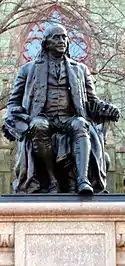

.JPG.webp)

.jpg.webp)